#nasuh efendi
Explore tagged Tumblr posts
Text


This brown coat was first worn by Matrakçı Nasuh Efendi in the twentieth episode of the third season of Magnificent Century.
It appeared again on Elif Baharvadi in the eighth episode of the second season of Tozkoparan İskender.
#Muhteşem Yüzyıl#Magnificent Century#Tozkoparan İskender#period drama#costume drama#historical drama#Matrakçı Nasuh#Nasuh Efendi#Matrakci Efendi#Elif Baharvadi#reused costumes#recycled costumes
3 notes
·
View notes
Note
Actually, I will give now one of records of Bayezid II's family composition, as addition of answer to user who asked about more infos and harem registers of Bayezid II-s daughters.
I don't give much credit to Öztuna, because he can often be imprecise and inaccurate. However, sometimes he is really accurate and says something we didn't know. We know just twelve daughters of Bayezid II: Hûndihan, Hatice, Selçûkşah, Şahzade (Sultanzade), Gevhermûlûk, Ayşe, Hûmaşah, Fatma, İlald��, Kamerşah, Şah andAynışah. Some of the historians (Öztuna, Uluçay, Alderson or someone else) mentioned that Bayezid II had fifteen or sixteen daughters in total, but I cannot remember who and where. Anyway, this may be right, and I will provide you proof why in following text...
In work: II.Bayezid devri in’amat defteri: Muharrem-Zi’l-hicce 910/Haziran Mayıs 1504-1505, I have found list of gifts provided to many Efendis, Beys, Pashas, and female members of Dynasty. Beside some relatives of Bayezid II through his aunt, brothers, mothers of his sons, consorts of his sons, nephews and nieces , grandchildren (like for example: duhter-i Cem Çelebi, duhter-i Sultan Mustafa, duhter-i Hamza Beg, valide-i hazret-i Şahenşah Beg, maderan-i evlad-i hazret-i Ahmed Beg, Ahmed Beg bin Sinan Paşa mirliva-i Vize, zevce-i Yunus Beg, duhteran-i Ahmed Mirza bin Ugurlu Mirza, duhter-i kûçek Sultan Abdullah, Osman Çelebi bin ‘Alem Beg etc…) , which I find unimportant, there were plenty of his daughters in 1505 who recieved gifts. To make it easier for you, and so that you don't have to search, I have singled out every of thirteen daughters of Sultan Bayezid that I found recorded who recieved gifts.
duhter-i hazret-i hullide mûlkûhû, zevce-i Mesih Beg, Mir-i Alem
duhter-i küçek, duhter-i hazret-i hullide mûlkûhû, zevce-i Mehmed Beg bin Mustafa Paşa, mirliva-i Hüdavendigâr
duhter-i küçek ve duhter-i hazret-i hullide mûlkûhû, zevce-i Mustafa Beg bin Çavid Paşa
duhter-i hazret-i hullide mûlkûhû, zevce-i Yahya Paşa, Mir-i Miran Vilayet-ili Rûm-ili
duhter-i hazret-i hullide mûlkûhû, zevce-i Sinan Paşa
duhter-i hazret-i hullide mûlkûhû, zevce-i köhne-i Hasan Beg Güzelce
duhter-i hazret-i hullide mûlkûhû, zevce-i Davud Beg, mirliva-i Nigboli
duhter-i hazret-i hullide mûlkûhû, zevce-i Nasuh Beg, mirliva-i Silistre
duhter-i hazret-i hullide mûlkûhû, zevce-i Mustafa Beg bin Davud Paşa
duhter-i hazret-i hullide mûlkûhû, zevce-i köhne-i Fa’ik Paşa
duhter-i hazret-i hullide mûlkûhû, zevce-i Hasan Bey, Aga’yi Yeniceriyan
duhter-i hazret-i hullide mûlkûhû, zevce-i Mehmed Beg bin Karli
duhter-i hazret-i hullide mûlkûhû, zevce-i Ahmed Paşa bin Mevlânâ Fenâri
valide-i Ahmed Mirza
What was most interesting to me, on page 73, I’ve found that mother of Ahmed Mirza, Gevherhan Sultan, recieved gifts, which means she was still alive in 1505. Among daughters of Bayezid II, I identify here:
Aynışah Sultan, wife of Yahya Pasha
Ayşe Sultan, wife of Sinan Pasha
Fatma Sultan, wife of Hasan Beg
Kamerşah Sultan, wife of Davud Beg
Şah Sultan, wife of Nasuh Beg
Hatice Sultan, wife of Faik Pasha
Hûmaşah Sultan, wife of Karlizade Mehmed Beg
It is obvious that three daughters of Bayezid II didn’t recieve gifts in 1505; Hûndihan, Selçûkşah, and Gevhermûlûk. They were at the time wives of (respectively) Hersekzade Ahmed Pasha, Gedik Ahmed Pasha’s son Mehmed Pasha and Dukakinzade Ahmed Pasha (not Dukakinzade Mehmed, I'll explain another time). Still, they were all alive in 1505.
The greatest surprise for me is that Hatice Sultan was still alive. I think that Öztuna claimed that Hatice died in 1500; and I think we all accepted that as her death year. But, it seems that she was still alive in 1505. Beside, Hatice Sultan’s son from her first marriage with (Kara) Mustafa Pasha, Mehmed Bey, became governor of Bursa (Hudavendigar) in 1503 and married a daughter of Bayezid II (thus half-sister of his mother. (Source: Männer um Bāyezīd ; page 301). And he is listed among grooms on list up there. This should not surprise you, as Bayezid II often practiced ‘’marriages close to home’’ i.e. incestuous marriages between his grandchildren.
P.S. Öztuna wrongly claims that Mehmed Bey married his aunt Selçûkşah Sultan, which is one of his greatest mishits. I’ll explain in another time especially why...
Beside wife of Hatice Sultan’s son Sultanzade Mustafa Bey, there were still four unidentified daughters of Bayezid II who were wives of Mesih Bey, Mustafa Bey (son of Çavid Paşa), Agha of the jannisaries Hasan and Ahmed Pasha (son of Mevlana Fenari). I really don’t know if one of these Pashas was husband of İlaldı Sultan, sister of Selim I. It’s hard to say if this Ahmed Pasha was same Hain Ahmed Pasha who was from Selim’s household.
But, interestingly, there were two of Bayezid’s daughters referred as duhter-i küçek (wives of Sultanzade Mustafa Bey and Çavid Paşa’s son) which means that they were the youngest of his daughters, probably born during his reign, in 1480s. Sadly, I wansn’t capable of finding their names, as nor for wives of Mesih Bey or Sultanzade Mustafa Bey...
Oh, actually that person wanted information on Şehzade Bayezid’s family lol I misunderstood.
That dissertation seems to give a lot of information. Hopefully, those registers were well translated (sometimes even Tezcan isn’t sure of some spellings)
Anyway, that list is certainly long, and it matches the one that Uluçay found in a salary register:
According to the mevacib book dated 1503 (909), Bayezid II's daughters were married to the following men: Mustafa Bey bin Davud Pasha, Hüdavendigâr Sancakbeyi Mehmed Bey bin Mustafa Pasha, Silistra Sancakbeyi Nasuh Bey; Sinan Pasha, Davud Bey, Ahmed bin Uğurlu Mirza, Rumeli Beylerbeyi Yahya Pasha, Muslih Bey can be seen in 1504-1505; Güzelce Hasan Bey in 1506-1507, Mehmed Bey bin Karlı in 1508 were included in the list of sons-in-law. Ferhad Bey's name is not found in the aforementioned mevacib books, on the other hand, Kapucubaşı Yunus Bey is included. If we add Hersekzade Ahmed Pasha to these, the list of sons-in-law is complete. It is known that Mehmed Bey, son of Mustafa Pasha, the Bey of the Sanjak of Hüdavendigar, had several daughters, one of whom married the son of İlaldı. (Uluçay, M. Çağatay - Padişahların Kadınları ve Kızları, p. 47)
Most of the damads correspond, after all.
Beside, Hatice Sultan’s son from her first marriage with (Kara) Mustafa Pasha, Mehmed Bey, became governor of Bursa (Hudavendigar) in 1503 and married a daughter of Bayezid II (thus half-sister of his mother. (Source: Männer um Bāyezīd ; page 301). And he is listed among grooms on list up there.
Mmmh, Öztuna says that Mehmed Bey was Kara Mustafa Pasha’s son from a previous marriage. Hatice was his step-mother: “His son, Dâmâd Mehmed Bey, married his stepmother, Hadîce Sultan's sister, Selçuk Sultan”. Regardless of the fact you think he got his wife wrong, Mehmed Bey was not a Sultanzade, it seems.
Actually, Öztuna says that Dukagin-zâde Ahmed Pasha was Gevhermûlûk Sultan’s husband, while Dukagin-zâde Sultanzade Mehmed Pasha was Ayşe Hanzade Mihrimah Hanımsultan (binti Ayşe Sultan)’s husband.
4 notes
·
View notes
Note
Hi! I’m currently watching MC for the first time (on episode 21) and this…Matracki chasing after Sadika arc is hitting the wrong buttons on me. I don’t know if it’s just that the show happened prior to the metoo movement but, Matracki is kind of being creepy. Sadika is just so uncomfortable with him and he never notices. What were your impression of their dynamic?
Second question: who is your favorite MC character and why?
Hi! As you said Matrakci was being creepy and chasing her. Every man in this series to the exception of Leo was creepy. I think the reason nasuh isn’t getting that she doesn’t like him is because she told him to be the messenger between her and her “uncle” and he was like “omfg she loves me she is just shy”. There isn’t really dynamic between them just Nasuh being delusional and Sadika is using this to get revenge.
I have lots of fave characters, my all time faves are Hurrem and Sumbul but that’s for reasons I won’t say to not spoil anything. Nigar tho in SO1 is my fave she is smart and opportunistic. I also have soft spot for Leo.
#magnificent century#muhteşem yüzyıl#Matrakci Nasuh efendi#sadika hatun#nigar kalfa#Sadika deserved way better#Sultan is an asshole for raping her
10 notes
·
View notes
Photo










Characters that deserved better- Muhtesem Yuzyil & Muhtesem Yuzyil: Kosem
1. Haseki Ayse Sultan
2. Mahidevran Sultan
3. Sehzade Mustafa
4.. Matrakci Nasuh Efendi
5. Seker Aga
6. Handan Sultan
7. Gevherhan Sultan
8. Sehzade Mehmed
9. Kalika Hatun
10. Mahfiruz Hatun
11. Sultan Mustafa I
12. Daye Hatun
#muhtesem yuzyil#muhtesem yuzyil kosem#magnificent century#magnificent century kosem#haseki ayse sultan#ayse sultan#Mahidevran Sultan#haseki mahidevran sultan#mahidevran hatun#seker aga#matrakci nasuh efendi#handan sultan#gevherhan sultan#mahfiruz hatun#daye hatun#kalika hatun#characters that deserved better#sehzade mustafa#sultan mustafa i#Mustafa I#sehzade mehmed#period drama#historical drama#historical characters#historical tv#fictional characters
62 notes
·
View notes
Text
Minyatür Sanatı Üzerine
İslam dünyasında resim sanatının temsilcisi olan minyatür, süsleyiciliği yanında kuvvetli bir anlatım gücüne ve kendisine has estetik bir yapıya sahip olarak, asırlar boyu değişik ve çok çeşitli üsluplar altında daima gelişimini sürdürmüştür. Genelde bir kitap resimleme sanatı olarak kabul edilerek, metni açıklayıcı ve destekleyici olarak yapılmaktadır. Minyatürün en büyük özelliği konuyu tam…

View On WordPress
#matrakçı kimdir#matrakçı nasuh efendi#matrakı&039;nın eserleri#miinyatür nasıl yapılır#minyatür incelikleri#minyatür nedir#minyatür örnekleri#minyatür sanatçıları#minyatür sanatı nedir
1 note
·
View note
Text
Bugün @hayatiinanc üstadın konferansına gitme niyetindeydim. İşimden dolayı gidemeyecektim. Lakin tevafuğa bakın ki bugün Nasuh Efendi Camii'nde aynı safta cuma namazı kıldık. Hayatta hiçbir şey raslantı değildir benim nazarımda. Değil mi ki kaderin üstünde bir kader varmış.
15 notes
·
View notes
Text
Non real life sultanas
A little Christmas surprise post comes. One of my most popular videos on Youtube was the one, where I gathered non-historical characters, explaining how fictional or how historical they were, and if there was a real historical person behind them as an inspirer. Now, for Christmas, I would like to summarize for you the main fictional characters of the Muhteşem Yüzyil series.
Several fictional characters were present in the Muhteşem Yüzyil series, many from the very first minutes. The presence of some fictional characters was forgivable, as we were left with very little detailed information about the harem of Sultan Suleiman I. Thus, for example, the characters of Sümbül Agha, Gül Agha, Mercan Agha, and other eunuchs, although not portraying historical characters, were necessary for the dramaturgy of the series. Sümbül's character was the most important among the eunuchs and perhaps this is why many of us may think that Hürrem actually had such a close friend in the person of the chief eunuch. However, this is not true. During Suleiman's reign, many chief eunuchs took turns, and none of them were known to be particularly close to Hürrem. Of Hürrem's close servants, only one is known by name, a woman named Nevbahar. The characters of Nigar Kalfa, Gülsah Hatun, Fidan Hatun, Daye Hatun, Fahriye Kalfa were similar to Sümbül. None of them were historical, but surely every sultana had their own trusted servants, as they showed in the series. Like the eunuchs and kalfas, the concubines of Prince Mustafa and Prince Bayezid, Ayşe, Rana, Defne or Rumeysa Hatun, can also be considered forgivable fictional characters. We do not know anything about the harem of the two princes as neither of them had a major consort and as their children were born from different women.
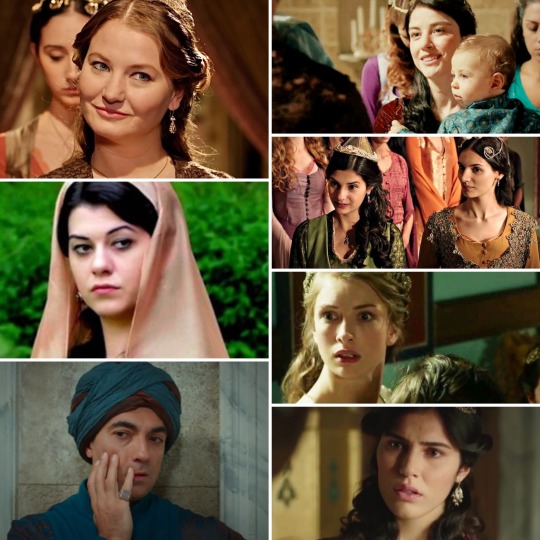
However, there were also characters who were written into the story just for the sake of the drama. Which of these characters was acceptable is up to everyone and feel free to write your opinion about them in a comment here or on another platform! So here's the long-awaited list:
Sadika Hatun
Sadika was a Hungarian woman in the series whose husband was killed by Sultan Suleiman on the day of their wedding. Sadika then became the spy of the Hungarian king, Lajos II and she traveled to Istanbul to personally avenge her husband’s death. Matrakci Nasuh Efendi then, by chance, meets the girl and helps her get into the harem, where she immediately joins Ayşe Hafsa Valide Sultan's service and then becomes Hatice Sultan’s chief servant. During her job, of course, she gets close to Suleiman's bed several times, and then she had the opportunity to attack the sultan. However, she does not succeed, Suleiman survives, and Sadika is thrown in the Bosphorus.
In reality, this story would not be possible at all. Even if we assumed that Sadika really existed and Suleiman actually killed her husband, she would not have been able to get into the Sultan's harem and take revenge. On the one hand, Sadika was already a married woman, an adult woman. Such women could not enter the harem, only virgin, child girls could become the sultan's later concubines. However, even if Sadika had somehow been able to get in the harem, a long education would have awaited her before she could join the Valide Sultan's service. While there may have been some exceptional cases where older or non-virgin women wanted to be gifted to the Sultan, these are special cases. Such was the case, for example, when Hayreddin Barbarossa wanted to kidnap the beautiful Giulia Gonzaga, a widowed Italian noblewoman known far and wide, to send her to the Sultan's harem as a gift. In the end, he didn’t succeed, but even if he did, we don’t know if the sultan would had ever taken the woman to his bed.
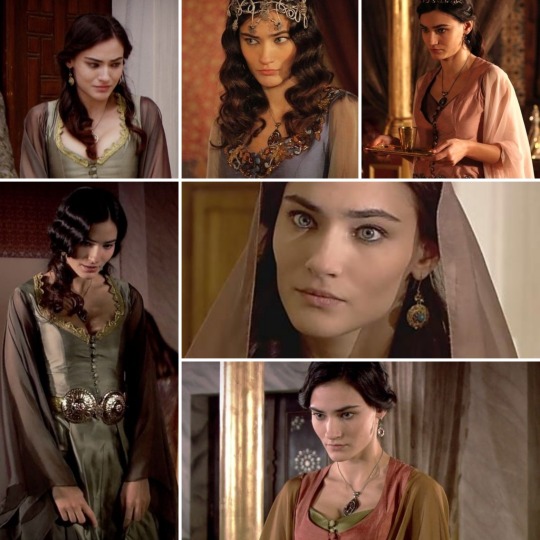
Leo
In the series, he was the love of Hürrem from their youth. Leo came to Istanbul with the goal of finding her former sweetheart. Leo is a talented artist who, with the help of Nasuh Efendi (ahh Nasuh brought all the good people near to the Sultan…) will become the painter of Sultan Suleiman and Pargali Ibrahim. His former relationship with Hürrem will soon be revealed to Pargali Ibrahim, who is thus trying to blackmail Hürrem. Hürrem repeatedly begs Leo to leave the capital, but the man remains, which eventually leads to his death.
In reality, Hürrem - and all the other concubines - were taken into Ottoman captivity as little girls, so it is out of the question that they would have had a love or a fiance. And even if they had, they could never have found them. Nasuh Efendi, though one of the greatest suckers in the series - yet the dearest character - was not like that in reality at all, but he was a wonderful scholar who, by the way, was not so closely friends with either Sultan Suleiman or Pargali Ibrahim.
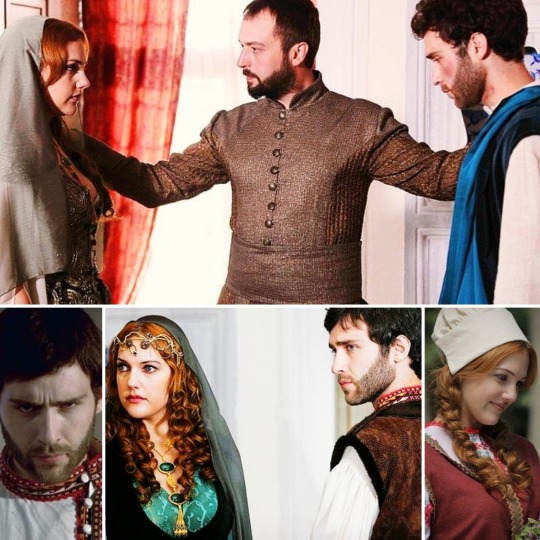
Princess Isabella
Princess Isabella Fortuna was a Spanish noble lady in the series who was on a ship to her future husband, the Austrian prince, when she was captured by Ottoman pirates and was taken to Istanbul to Sultan Suleiman. At first, Suleiman was only interested in the princess for political reasons, but later he fell in love. Princess Isabella initially resisted Suleiman's approach with all her cartilage, but over time she fell in love with the sultan and became his lover. This, of course, Hürrem could not stand and did everything she could to get rid of the princess who was eventually sent home by Suleiman himself.
In reality, of course, such a situation would have been unthinkable. Even assuming that Isabella existed and was captured by pirates, no princess raised in the Catholic faith would have voluntarily become the concubine of a Muslim sultan, she would have committed suicide instead. Let us not forget that Suleiman was loyal to Hürrem from the 1520s onwards, so in reality there was not a single woman who could make hard time for Hürrem during her decades-long relationship with Suleiman. Isabella Fortuna, on the other hand, never existed. Surprisingly, however, they could have patterned her from a real character. There was an Isabella of Castile in this period who was born in 1518 as the child of the widowed Queen of Aragon, Germaine of Foix and Charles V, but she was never captured by Ottoman pirates and was never the bride of the Austrian prince. Isabella's existence was kept secret by her parents all her life, only her mother's testament revealed that she ever existed. It is also known from there that Isabella died young in 1537.
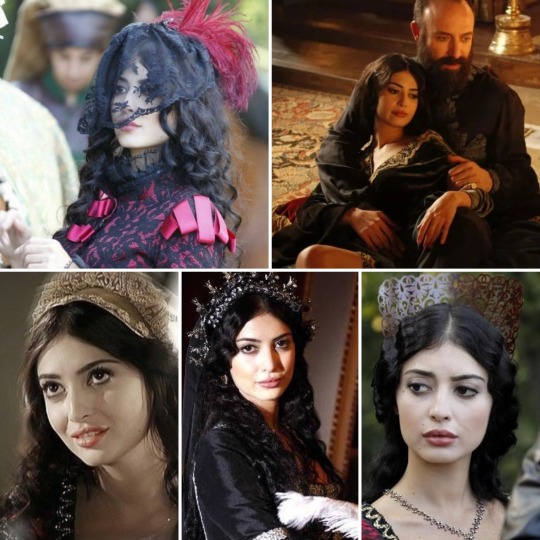
Aybige Hatun
In the series, Aybige was the niece of Ayşe Hafsa, and so the daughter of the Crimean Sahib Giray khan. Aybige originally only came to visit her aunt in Istanbul, but later Hafsa Sultan wanted to see her as the wife of her favorite grandson, Prince Mustafa. However, Aybige was in love with Bali Bey and Mustafa longed for someone else aksi. Bali Bey was eventually almost executed for their love, and Aybige returned to Crimea with her father in the end.
Aybige’s storyline makes mistakes at almost every point. First, Ayşe Hafsa was never the sister of the Crimean khan, so the daughter of the Crimean khan could not have been her niece either. In addition, although Sahib Giray Khan had several daughters, none were called Aybige and none of his daughters ever traveled to Istanbul. The only true point in the whole storyline is that Sahib Giray Khan really collaborated with Sultan Suleiman in his Moldovan war. It is also important to mention Bali Bey at this point. Although Bali Bey was a real historical figure, there is not the slightest match between historical Bali Bey and the series Bali Bey. The real Bali Bey was not a romantic guy who fell in love with every second woman. Bali Bey was a cruel warlord. And if it comes to Bali Bey, let’s say a few words about Prince Mustafa as well. The idea of wanting to marry Mustafa to a khan’s daughter is completely absurd! Since the reign of Sultan Mehmed II, princes have been forbidden to marry anyone, so Prince Mustafa has not been allowed to marry anyone either. And the fact that Suleiman would have supported the idea - even if such a marriage had been able to occurre at all - is an even greater absurdity. Suleiman did not want Mustafa as his heir, so he would never have given him as much power as the support of the Crimean khan.

Firuze Hatun
In the series, Firuze was a Persian spy who, with her amazing abilities, was able to heal the pains of the sick Prince Cihangir, earning the love of Hürrem Sultan. Firuze, however, thanked Hürrem kindness in a disgusting way, and became Suleiman's secret lover, whom the sultan fell in love with. In the end, Hürrem was only able to overcome Firuzen with a little, Firuze was eventually exiled from the palace so she could return to Persia.
In reality, Suleiman was loyal to Hürrem, living in a monogamous relationship with her. Even if there was an occasional one-night-stands, Suleiman never fell in love with another woman, only Hürrem. Thus, the Firuze storyline has already failed here. The fact that there was a Persian spy in the harem would have been an interesting suggestion though. There were certainly spies in the royal court of every empire, but they were probably not hiding among the concubines. Eunuchs, for example, moved with much greater freedom, were much better candidates for being a spy…
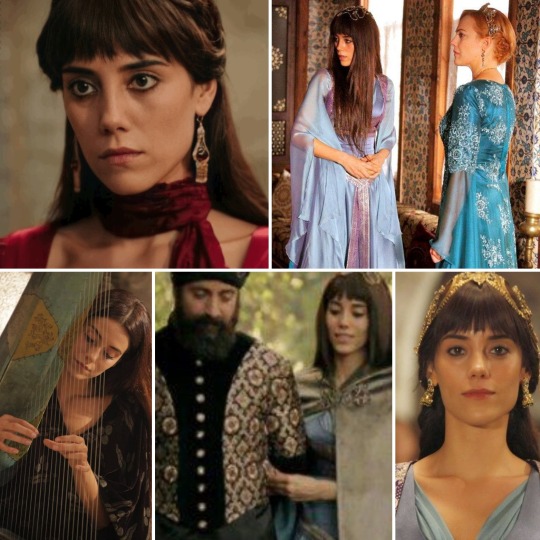
Huricihan Sultan
In the series, Huricihan was the daughter of Ibrahim Pasha and Hatice Sultan, who grew up in the palace of Beyhan Sultan after the death of her parents. From there she returned to Istanbul, where she fell in love with her first cousin, Prince Bayezid. Their love became a relationship and then marriage without the Sultan’s permission. Huricihan became the head of Bayezid's harem and soon her relationship with Hürrem and Suleiman slowly became better. Huricihan's end eventually was brought by Prince Selim's concubine, Nurbanu, who knocked her out in the heat of a dispute, killing her.
In reality, Hatice and Ibrahim Pasha were never married, so they didn't have children either together, so Huricihan never existed. If she had existed, for the reasons already mentioned, it would have been utterly inconceivable for Bayezid to marry her, either secretly or openly. Especially knowing that Bayezid had never had a favourite singled out concubine, as all of his children were born to different women. With a background like this, it’s unlikely he’d ever wanted to marry anyone. Although Hatice Sultan did indeed have a daughter, she was born between 1510 and 1515, so she was well ahead of Bayezid in age, and of course she had nothing to do with the prince and was not even called Huricihan.
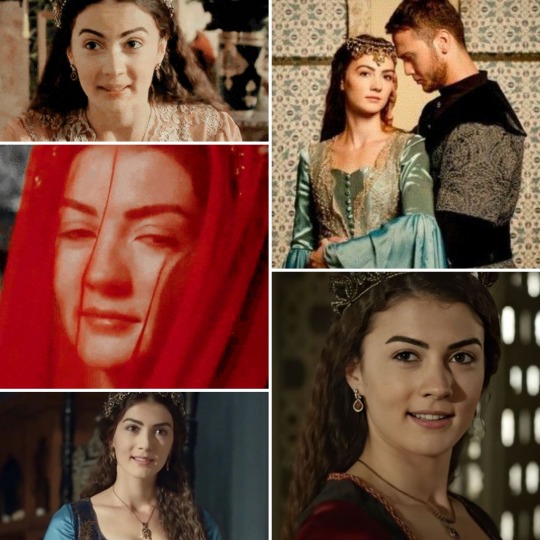
Mihrünissa Hatun
In the series, Mihrünissa was the daughter of Hayreddin Barbarossa the Head of the Fleet, whom her father sent to Prince Mustafa as a consultant. Later, the two young person fell in love with each other and married without the Sultan's knowledge. In time, Mihrünissa also gave birth to Mustafa's son Mehmed. After Prince Mustafa and his son Mehmed were executed, Mihrünissa went to the capital and cut her own throat before Hürrem's eyes.
In reality, for the reasons already detailed several times above, no prince could marry anyone, so Mustafa also never married. In addition, Barbarossa never had a daughter named Mihrünissa and Hayreddin Pasha was never a supporter of Prince Mustafa. However, even assuming that Mihrünissa existed, there is no chance that she could have committed suicide before Hürrem's eyes. Prince Mustafa's harem retired to Bursa, so that no member of the harem could travel to the capital, especially not to the palace and kill herself in front of Hürrem. So, in fact, the Mihrünissa storyline was just 100% fiction.

Nazenin Hatun
In the series, Nazenin arrived in Istanbul with Nurbanu, where Hürrem, who was struggling with menopause, sent her to the sultan herself. Nazenin thus became the sultan's concubine and soon gave birth to a daughter, Raziye Sultan. Eventually, on Hürrem's instructions, she was killed by Nurbanu.
In reality, as I have said many times, Suleiman was loyal to Hürrem. In addition, after the birth of Prince Cihangir in 1531/2, Suleiman had no more children, neither to Hürrem nor to anyone else. It is true that he had a daughter named Raziye, however, the child died in 1520 at the age of a few years as a result of an epidemic.

Surprising realities
After many fictional characters, one would think that all eunuchs and kalfas were fictional characters, as we know quite a bit about the harem. However, this is not true! There were some historically inspired characters, such as Gazanfer Agha, who, although existed and was one of the most influential eunuchs ever, was not a loyal man of Nurbanu, but Sultan Selim II. Gazanfer reached the peak of his career, by the way, during the reign of Safiye Sultan.
Similarly historical was Canfeda Hatun, who was Nurbanu’s most loyal servant and one of the most influential kalfas of her era. True, Canfeda’s character in the series was a fusion of two loyal servants of historic Nurbanu. In her young age, in the princely harem of Selim, Nurbanu became acquainted not with Canfeda but with another kalfa, who remained her faithful servant for the rest of her life. Canfeda only became Nurbanu’s main supporter during Selim’s reign.
Like them, Afife Hatun’s character was partly real also. Sultan Suleiman's wetnurse was really called Afife and the sultan always kept in touch with the woman. However, Afife Hatun never moved to Istanbul to rule the Sultan’s harem, but lived a simple life.
Gracia Mendes Nasi was introduced last season as a wealthy Portuguese Jewish woman who helped Portuguese refugees get to Istanbul. Later, Gracia became the lover of Grand Vizier Rüstem Pasha, which made her an enemy of Mihrimah Sultan. In reality, Gracia Mendes was a very benevolent soul who was committed to Jewish traditions and her Jewish brothers. She was never a lover of Rustem and an enemy of Mihrimah. However, like the series, Gracia actually enjoyed the Sultan’s support and, with his help, she made great improvements in Istanbul’s Jewish Quarter and helped many refugees start a new life in the Ottoman Empire.
One of the most interesting guest actors of the last season of the series was Anna Jagello, the daughter of the former King of Poland, the sister of the new King of Poland. Although the woman was a real historical figure, the historical Anna never traveled to Istanbul and never corresponded with Hürrem Sultan. However, Hürrem exchanged letters several times with Anna's mother Bona Sforza, Anna's father, King Sigismund I of Poland, and Anna's brother, the later Zsigmond Ágost II king of Poland, and even Anna's sisterm Isabella, the Hungarian queen. Thanks to the intercession of Hürrem, the relationship between the Kingdom of Poland and the Ottoman Empire was quite good and almost friendly during Suleiman's reign.
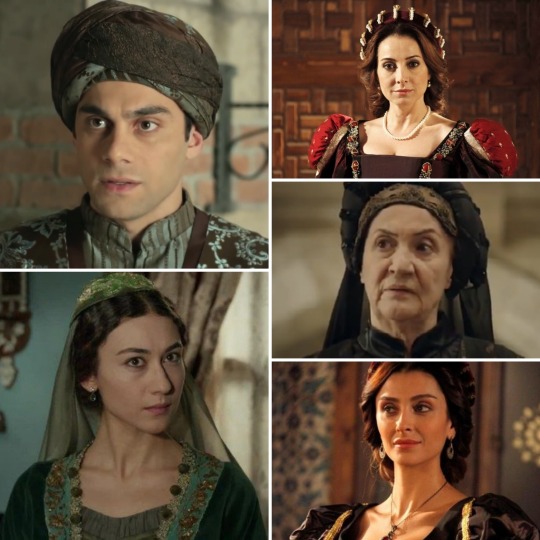
* * *
Egy kis karácsonyi meglepetés poszt következik. Youtube-on az egyik legnépszerűbb videóm az volt, amelyben a nem történelmi karaktereket gyűjtöttem össze, elmagyarázva, mennyire voltak kitaláltak, mennyire volt mögöttük egy-egy valós történelmi személy, mint ihlető. Most karácsony alkalmából szeretném nektek összefoglalni a Muhteşem Yüzyil sorozat főbb kitalált karaktereit és történetüket.
A Muhteşem Yüzyil sorozatban több kitalált karakter is jelen volt, sokan már az első percektől kezdve. Egyes kitalált karakterek jelenléte megbocsátható volt, hiszen nagyon kevés részlet maradt ránk a Szulejmán háremében jelenlévő személyekről. Így például Sümbül Aga, Gül Aga, Mercan Aga és más eunuchok karakterei bár nem valódi személyeket keltenek életre, szükségesek voltak a sorozat dramaturgiája szempontjából. Sümbül karaktere volt a legfontosabb az eunuchok között és talán emiatt sokan gondolhatjuk úgy, hogy Hürremnek a valóságban is volt egy ilyen közeli barátja a fő eunuch személyében. Azonban ez nem igaz. Szulejmán uralkodása alatt rengeteg főeunuch váltotta egymást és egyikről sem ismert, hogy különösebben közel álltak volna Hürremhez. Hürrem közeli szolgálói közül csupán egy ismert név szerint, egy Nevbahar nevű nő. Sümbülhöz hasonló volt Nigar Kalfa, Gülsah Hatun, Fidan Hatun, Daye Hatun, Fahriye Kalfa karaktere is. Egyikük sem valós személy volt, ám bizonyosan minden szultánának megvoltak a saját megbízható szolgálói, ahogy ezt a sorozatban is mutatták. Hasonlóan az eunuchokhoz és kalfákhoz megbocsátható füllentésnek tekinthetőek Musztafa herceg és Bayezid herceg ágyasai is, Ayşe, Rana, Defne vagy Rumeysa Hatun. A két herceg asszonyairól ugyanis semmit sem tudunk, egyiküknek sem volt kiemelt jelentőségű főágyasa, gyermekeik más-más nőktől születtek.
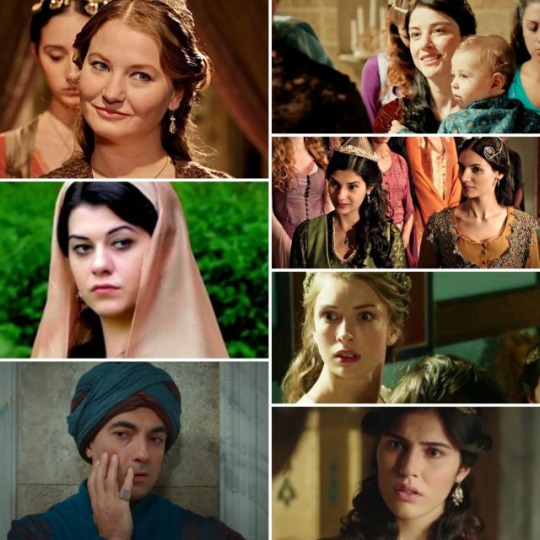
Voltak azonban olyan karakterek is, akiket csupán a dráma kedvéért írtak bele a történetbe. Az, hogy ezek közül melyik karakter mennyire volt elfogadható, azt mindenki maga döntse el és nyugodtan írja meg kommentben itt vagy más platformon, hogy mit gondol róluk! Következzék hát a várva várt lista:
Sadika Hatun
Sadika a sorozatban egy magyar nő volt, akinek férjét az esküvőjük napján megölte Szulejmán szultán. Sadika ezek után a magyar király, II. Lajos parancsára Isztambulba utazott, hogy ott személyesen bosszulja meg férje halálát. Matrakci Nasuh Efendi aztán egy véletlen folytán megismerkedik a lánnyal és segít neki bekerülni a hárembe, ahol azonnal Ayşe Hafsa Valide Sultan szolgálatába áll, majd Hatice Sultan főszolgálója lesz. Menetközben természetesen többször is Szulejmán ágyának közelébe kerül, majd lehetősége nyílik a szultánra támadni. Azonban nem jár sikerrel, Szulejmán életben marad, Sadikát pedig a Boszporuszba fojtják.
A valóságban ez a történetszál egyáltalán nem lenne lehetséges. Ha feltételeznénk is azt, hogy Sadika valóban létezett és Szulejmán valóban megölte a férjét, akkor sem állt volna módjába bejutni a szultáni hárembe és bosszút állni. Egyrészt Sadika férjezett asszony volt már, felnőtt nő. A hárembe nem kerülhettek be ilyen nők, csupán szűz, gyermeklányokból válhattak a szultán ágyasai. Mindazonáltal ha Sadika valahogy mégis bekerült volna a hárembe hosszadalmas oktatás várt volna rá, mielőtt a Valide Sultan szolgálatába állhatott volna. Előfordulhatott ugyan néhány kivételes eset, amikor idősebb vagy nem szűz nőket akartak volna a szultánnak ajándékozni, azonban ezek különleges esetek. Ilyen volt például, amikor Hayreddin Barbarossa el akarta rabolni a messze földön ismert, gyönyörű Giulia Gonzagát, megözvegyült itáliai nemesasszonyt, hogy a szultán háremébe küldje ajándéknak. Végül nem járt sikerrel, ám ha sikerrel járt volna is, nem tudni, hogy a szultán valaha is ágyba vitte volna-e a nőt.
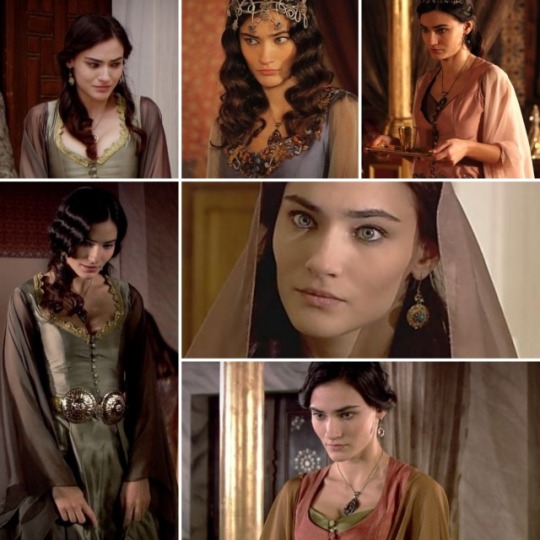
Leo
A sorozatban Leo Hürrem fiatalkori szerelme volt, aki azzal a céllal érkezett Isztambulba, hogy megtalálja egykori kedvesét. Leo tehetséges művész, aki Nasuh Efendi segítségével (ahh Nasuh csupa jó embert juttatott a szultán közelébe…) Szulejmán szultán és Pargali Ibrahim festője lesz. Egykori viszonya Hürremmel hamarosan kiderül Pargali Ibrahim számára, aki ezzel próbálja zsarolni Hürremet. Hürrem többször könyörög Leonak, hogy hagyja el a fővárost, de a szerelmes férfi marad, ami végül halálához vezet.
A valóságban Hürrem – és minden más ágyas – még kislányként került oszmán fogságba, tehát kizárt, hogy szerelmük vagy vőlegényük lett volna, ha pedig mégis, az sosem tudott volna rájuk találni. Nasuh Efendi, pedig aki a sorozat egyik legnagyobb baleke – ugyanakkor legkedvesebb karaktere – a valóságban egyáltalán nem ilyen volt, hanem egy csodálatos tudós, aki egyébként nem állt ilyen közeli barátságban sem Szulejmán szultánnal, sem Pargali Ibrahimmal.
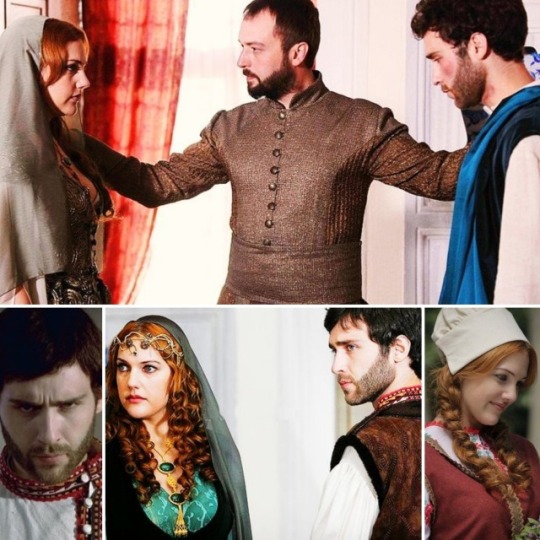
Izabella Hercegnő
Izabella Fortuna hercegnő a sorozatban egy spanyol nemes hölgy volt, aki éppen jövendőbeli férjéhez, az osztrák herceghez tartott hajón, mikor az oszmán kalózok elragadták és Isztambulba vitték Szulejmán szultán elé. Először Szulejmán politikai okokból érdeklődött csupán a hercegnő iránt, később azonban beleszeretett. Izabella hercegnő eleinte minden porcikájával ellenállt Szulejmán közeledésének, idővel azonban beleszeretett a szultánba és a szeretője lett. Ezt természetesen Hürrem szultána nem állhatta és mindent megtett, hogy megszabaduljon a hercegnőtől, akit végül Szulejmán küldött el.
A valóságban természetesen elképzelhetetlen lett volna egy ilyen szituáció. Ha feltételezzük is, hogy Izabella létezett és a kalózok fogságába esett, egyetlen katolikus hitben nevelt hercegnő sem vált volna szabad akaratából a szultán ágyasává, előbb lett volna öngyilkos. Azt se felejtsük el, hogy Szulejmán az 1520-as évektől kezdve hűséges volt Hürremhez, a valóságban nem volt egyetlen nő sem, aki éket verhetett volna közéjük több évtizedes kapcsolatuk alatt. Másrészről pedig Izabella Fortuna sosem létezett. Meglepő azonban, hogy valós karakterről mintázhatták. Létezett egy Kasztíliai Izabella ebben a korban, aki 1518-ban született az özvegy aragóniai királyné Germaine Foix és V. Károly gyermekeként, azonban sosem esett oszmán kalózok csapdájába és sosem volt az osztrák herceg menyasszonya. Izabella létezését egész életében titokban tartották szülei, csupán édesanyja végrendeletéből derült fény arra, hogy valaha is létezett. Innen tudni azt is, hogy Izabella fiatalon elhunyt 1537-ben.
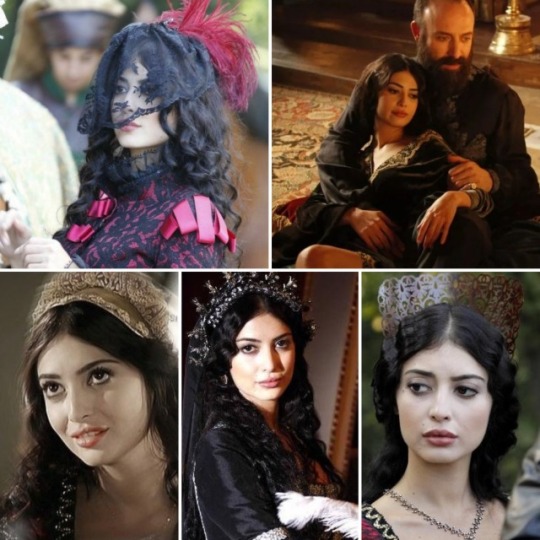
Aybige Hatun
A sorozatban Aybige Ayşe Hafsa Sultan unokahúga volt, a krími Sahib Giray kán lánya. Aybige eredetileg csak látogatóba érkezett Isztambulba, később azonban nagynénje szerette volna őt kedvenc unokája, Musztafa herceg feleségeként látni. Aybige azonban Bali Bégbe volt szerelmes és Musztafa is más után vágyakozott. Bali Béget végül majdnem kivégezték a szerelmük miatt, Aybige pedig apjával visszatért a Krímre.
Aybige történetszála szinte minden létező ponton hibádzik. Először is, Ayşe Hafsa sosem volt a Krími kán testvére, tehát a krími kán lánya sem lehetett az unokahúga. Emellett Sahib Giray kánnak bár több lánya volt, egyiket sem hívták Aybigének és egyik lánya sem utazott sosem Isztambulba. Az egész történetszál egyetlen igaz pontja, hogy Sahib Giray kán tényleg együttműködött Szulejmán szultánnal annak moldáv háborújában. Fontos megemlíteni ezen a ponton Bali Béget is. Bali Bég bár valós történelmi személy volt, de a legkisebb egyezés sincs a történelmi Bali Bég és a sorozat Bali Bége között. A valódi Bali Bég nem egy romantikus fickó volt, aki minden második nőbe beleszeretett, és akiért bolondultak a nők. Bali Bég egy kegyetlen hadvezér volt. És ha már Bali Bég szóba jött, ejtsünk néhány szót Musztafa hercegről is. Az ötlet, hogy Musztafát egy kán lányához akarják adni teljesen abszurd! II. Mehmed szultán uralkodása óta tilos volt a hercegeknek házasságot kötni, így Musztafa herceg sem köthetett senkivel házasságot. Az pedig, hogy Szulejmán támogatta volna az ötletet, már ha egyáltalán felmerült volna egy ilyen házasság, még nagyobb abszurdum. Szulejmán nem Musztafát akarta örökösének, így sosem adott volna a kezébe akkora hatalmat, mint a krími kán támogatása.

Firuze Hatun
A sorozatban Firuze egy perzsa kém volt, aki csodálatos képességeivel gyógyítani tudta a beteges Cihangir herceg fájdalmait, amivel kiérdemelte Hürrem szeretetét. Firuze azonban rút módon hálálta meg Hürrem kedvességét, ugyanis Szulejmán titkos szeretője lett, akibe a szultán halálosan beleszeretett. Végül Hürrem csak egy hajszállal volt képes felülkerekedni Firuzén, akit végül száműztek a palotából, így visszatérhetett Perzsiába.
A valóságban Szulejmán hűséges volt Hürremhez, monogám kapcsolatban éltek. Ha előfordult is alkalomadtán egy-egy egyéjszakás kaland, Szulejmán soha nem szeretett bele más nőbe, csak Hürremet szerette. Így a Firuze történetszál már itt el is bukott. A tény, hogy Firuze perzsa kém lett volna érdekes felvetés, bizonyára akadtak kémek minden birodalom királyi udvarába, azonban ők valószínűleg nem az ágyasok között rejtőztek. Az eunuchok például, sokkal nagyobb szabadsággal mozogtak, sokkal könnyebben lefizethetők voltak…
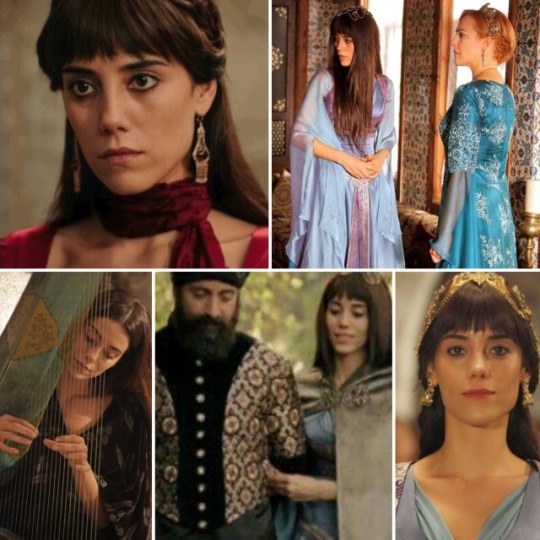
Huricihan Sultan
A sorozatban Huricihan Ibrahim Pasa és Hatice Sultan lánya volt, aki szülei halála után Beyhan Sultan palotájában nevelkedett. Onnan tért vissza Isztambulba, ahol beleszeretett elsőunokatestvérébe, Bayezid hercegbe. Szerelmükből kapcsolat, majd házasság lett a szultán engedélye nélkül. Huricihan Bayezid háremének feje lett és kapcsolata lassanként rendbejött Hürremmel és a szultánnal is. Huricihan végzete végül Szelim herceg ágyasa, Nurbanu lett, aki egy vita hevében leütötte őt, ezzel megölve.
A valóságban Hatice és Ibrahim Pasa sosem voltak házasok, így gyermekük sem született, tehát Huricihan sosem létezett. Ha létezett volna is, a már korábban említett okokból teljesen elképzelhetetlen lett volna, hogy Bayezid feleségül vegye őt akár titokban, akár nyíltan. Különösen tudva, hogy Bayezidnek nem volt sosem kiemelt ágyasa, minden gyermeke más nőtől született. Ilyen háttérrel nem valószínű, hogy valaha is feleségül akart volna venni bárkit. Hatice Sultannak bár valóban volt egy lánya, az 1510-1515 között született, így korban jóval megelőzte Bayezidet, és természetesen sosem volt semmi köze a herceghez és nem is Huricihannak hívták.
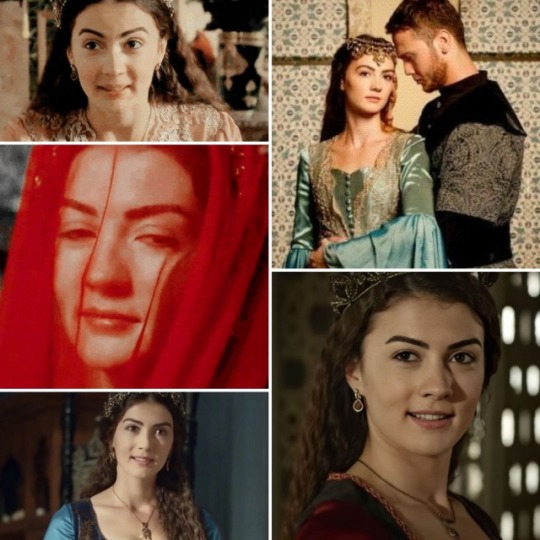
Mihrünissa Hatun
A sorozatban Mihrünissa Hayreddin Barbarossa flotta parancsnok lánya volt, akit édesapja küldött Musztafa herceg mellé tanácsadónak. Később a két fiatal egymásba szeretett és a szultán tudta nélkül egybe keltek. Idővel Mihrünissa életet adott Musztafa fiának, Mehmednek is. Miután Musztafa herceget és vele együtt fiát, Mehmedet is kivégezték, Mihrünissa a fővárosba ment és Hürrem szeme láttára elvágta a saját torkát.
A valóságban a már fent többszörösen részletezett okok miatt egy herceg sem köthetett házasságot, így Musztafa sem nősült meg soha. Emellett Barbarossának sosem volt Mihrünissa nevű lánya és Hayreddin Pasa sohasem volt Musztafa herceg támogatója. Ha azonban feltételeznénk is, hogy Mihrünissa létezett, nincs arra esély, hogy Hürrem szeme láttára lehetett volna öngyilkos. Musztafa herceg háreme Bursába vonult vissza, így a hárem egyik tagja sem utazhatott egyetlen percre sem a fővárosba, nemhogy a palotába, Hürrem elé. Így tulajdonképpen a Mihrünissa történet-szál 100%-ban kitaláció volt.

Nazenin Hatun
A sorozatban Nazenin Nurbanuval együtt érkezett Isztambulba, ahol aztán a menopauzával küszködő Hürrem maga küldte őt a szultán elé. Nazenin így a szultán ágyasa lett és hamarosan egy lánygyermeknek, Raziye Sultannak adott életet. Végül Hürrem utasítására Nurbanu ölte meg.
A valóságban, mint már sokszor mondtam, Szulejmán hűséges volt Hürremhez. Emellett Cihangir herceg 1531/2-es születése után Szulejmán nem nemzett több gyermeket, sem Hürremnek sem másnak. Az igaz, hogy volt egy Raziye nevű kislánya, azonban a gyermek 1520-ban néhány éves korában elhunyt egy járvány következtében.

Meglepő valóságok
A sok kitalált karakter után azt gondolhatnánk, hogy az összes eunuch és kalfa kitalált karakter volt, hiszen meglehetősen keveset tudunk a háremről. Azonban ez nem igaz! Volt néhány történelmi ihletésű karakter, mint például Gazanfer Aga, aki bár létezett, és a valaha volt egyik legbefolyásosabb eunuch volt, nem Nurbanu hű embere volt, hanem II. Szelim szultáné. Gazanfer pályája csúcsát egyébként Safiye Sultan uralkodása alatt érte el.
Hasonlóan valós volt Canfeda Hatun is, aki Nurbanu leghűségesebb szolgálója volt és az egyik legbefolyásosabb kalfája korának. Igaz, Canfeda sorozatbeli karaktere, a történelmi Nurbanu két hűséges szolgálójának ötvözéseként született meg. Nurbanu fiatal korában, Szelim hercegi háremében nem Canfedával, hanem egy másik kalfával ismerkedett meg, aki élete végéig hűséges szolgálója maradt. Canfeda csak Szelim uralkodása alatt került képbe és vált Nurbanu fő segítőjévé.
Hozzájuk hasonlóan Afife Hatun karaktere is részben valós volt. Szulejmán szultán szoptatósdajkáját tényleg Afifének hívták és a szultán mindig tartotta a kapcsolatot az asszonnyal. Azonban Afife Hatun sosem költözött Isztambulba, hogy irányítsa a szultáni háremet, hanem egyszerű életet élt.
Gracia Mendes Nasi az utolsó évadban került bemutatásra, mint gazdag portugál zsidóasszony, aki portugál menekülteknek segített Isztambulba jutni. Később Gracia a nagyvezír Rüsztem Pasa szeretője lett, aminek köszönhetően szembe került Mihrimah szultánával. A valóságban Gracia Mendes igen jótét lélek volt, aki elkötelezett volt a zsidó hagyományok és zsidó testvérei iránt. Sosem volt Rüsztem szeretője és Mihrimah ellensége. Azonban a sorozathoz hasonlóan, Gracia a valóságban is élvezte a szultán támogatását és segítségével nagy fejlesztéseket vitt véghez Isztambul zsidó negyedében és nagyon sok menekültnek segített új életet kezdeni az Oszmán Birodalomban.
A sorozat utolsó évadának egyik legérdekesebb vendégszereplője Jagelló Anna volt, az egykori lengyel király lánya, az új lengyel király testvére. Bár az asszony valós történelmi személy volt, a történelmi Anna sosem utazott Isztambulba és sosem levelezett Hürrem szultánával. Azonban Hürrem többször is váltott levelet Anna édesanyjával Bona Sforzával, Anna édesapjával, I. Zsigmond lengyel királlyal, valamint Anna testvérével, a későbbi II. Zsigmond Ágost lengyel királlyal, sőt Anna másik testvérével Izabella, magyar királynővel is. Hürrem közbenjárásának köszönhetően Szulejmán uralkodása alatt meglehetősen jó, szinte baráti volt a viszony a Lengyel Királyság és az Oszmán Birodalom között.
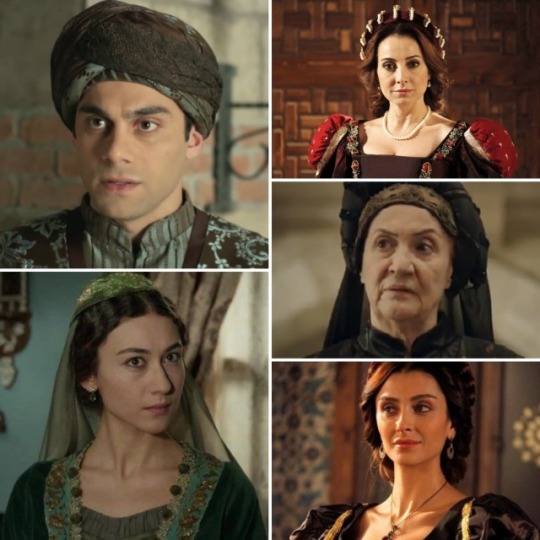
#selim ii#gazanfer agha#gazanfer#suleiman the magnificent#safiye sultan#suleiman i#suleyman i#haseki hürrem sultan#hürrem sultan#nurbanu sultan#aybige hatun#ayse hafsa#ayse hafsa sultan#princess isabella#firuze#firuze hatun
101 notes
·
View notes
Text
KANUNİ'NİN ( MUHİBBİ) EDEBİ YÖNÜ
Arapça, Farsça, ve Sırpçayı çok iyi bilen Kanûnî Sultan Süleyman doğu İslam kültürüne vakıf olduğu gibi batı kültürünü de çok iyi tanımaktaydı. Kanûni Sultan Süleyman, Türk Divan Edebiyatı ve şiirine eşsiz ve ebedi mısralar kazandıran ve en çok şiir yazan şairlerimizin başında gelir. Muhibbî, aşk ıstırabı, kanaat, tevazu, felekten şikâyet gibi, her divan şairinde görülen klasik konuları işlemiştir. Çağdaşı olan 'Zati den sonra en çok şiir yazan divan şairidir. Bunca devlet işi, seferleri, savaşları ve diğer işleri arasında bu kadar şiir yazabilmiş olması oldukça şaşırtıcı bir durumdur.
Kanuni sadece edebiyata değil müziğe, minyatüre ve el sanatlarına da çok değer veren bir hükümdardı. Zamanında HAYALİ, BAKİ, Zati, Taşlıcalı Yahya, Usuli, FUZULİ', gibi çok değerli şairler yetişmiş bu şairlerin pek çoğuna ihsanlarda bulunmuştur. Osmanlı devrinin en önemli Minyatürcülerin olan Matrakçı Nasuh'u da korumuş, pek çok seferine Matrakçı Nasuh ’u da götürmüş fethedilen ve görülüp gezilen yerlerin minyatürlerini de yaptırtmıştır.
En sevdiği adamlarından biri olan PARGALI İBRAHİM PAŞA ile tanışması onun sanata ve sanatçıya verdiği değeri göstermesi bakımından önemlidir. Manisa da Şehzade olarak görev yaparken bir evden keman sesi duyarak kimin çaldığını öğrenmek istemiştir. Kemanı çalan kişi PARGALI İBRAHİM ’dir. Bunun üzerine PARGALI İBRAHİM ’i yanına almış ve uzun müddet yanında muhafaza etmiş, şehzadeliği sırasında onu doğancı başı, hükümdarlığı esnasında da Has odabaşlığına kadar yükseltmiştir.
Bu büyük hükümdarın devrinde yüzlerce büyük sanatçı, mimar, Minyatürcü, Şair , yazar, coğrafya bilgini yetişmiştir. Edebiyyata;a HAYALİ, BAKİ ,Zati , Taşlıcalı Yahya, Usuli, FUZULİ', gibi İlim’de; Zenbilli Ali Efendi, İbn Kemal ( Şeyh'ül islam- Kemal Paşazade- ve Ebussuud Efendi… Mimaride; Koca Sinan… Tarih’te; Selanikî Mustafa, Âli, Celâlzâde Mustafa, Nişancı Mehmet… Coğrafyada; Piri Reis,… Denizcilikte; Barbaros Hayreddin Paşa ve Turgut Reis… Minyatürde Matrakçı Nasuh. Önde gelen isimlerdendir.
Muhibbi beğendiği şairler olarak,Ali Şir Nevai, (15.yy) ,,Genceli Nizami , Hafızı Şirazi gibi şairlerin ismini zikreder. Çağdaşları Fuzuli, Baki, Hayali gibi dev şairlerin ismini zikretmez. [7]Onun üzerinde en çok etki eden şair olarak Nizami Gencevi gösterilebilir. Şiirlerini ince hayal, nazik ve rengin edasıyla Nizami’nin şiirlerine benzetir. [8] Kanuninin Muhibbi mahlası ile yazılmış bir divanı vardır. Muhibbî, kelime manası olarak Arapça "hubb" kökünden "seven, sevgi besleyen, dost" anlamlarına gelir. Muhibbî veya vezin gereği nadiren de olsa Muhib, Sultan Süleyman, Meftûnî, Âcizî mahlaslarını kullandığı hacimli divanında tam 2779 adet gazel bulunmaktadır ki, Divan şairleri arasında en fazla gazel yazmış olan Zâtî'nin bile ulaştığı gazel sayısı 1825'tir. Kanuni böylece Divan edebiyatının gazel rekorunu kırmıştır.[9]
Devrinin ünlü şairlerinden HAYALİ, BAKİ ,Zati , FUZULİ', gibi şairlerin etkisinde kalan Muhibbî, İran şiirinde de başta Genceli Nizami olmak üzere Selman ve SA'Dİ ŞİRAZİ den etkilenmiştir. Bazen şiirlerinde vezin bulamamış şekil ve ahengi bozmuştur. Çok şiir yazması ve yazdıklarıyla yeniden uğraşacak vakit bulamamasından dolayı devrinde ikinci sınıf bir şair olarak tanınmıştır.[10] Şiirlerinde devrinin örf adet, inanç ve zevkini yansıtırken, deyimlerden, atasözlerinden sosyal hayata dair unsurlardan faydalanmıştır. Vezne pek dikkat edememekten kaynaklanan ahenk bozukluklarına düştüğü birçok şiirinden şiirlerinin üzerinde çok durmadığı anlaşılır. Bu kusurlara düşmesinin diğer bir nedeni de çok sayıda şiir yazmış olması gösterilebilir.
Şiirlerinde Şehzade Cem Sultan,ve Avni- (Fatih Sultan Mehmet 'in de etkileri görülür. Devrinin diğer şairleri gibi aşk ve tabiat konularının dışına çıkamamıştır. Yalnız bir-iki şiirinde kahramanlık duygularını işlemiş, İran üzerine askeri ile yürümeyi arzu ettiğini dile getiren kahramanlık konulu şiirler yazmıştır. Askerlik ve harp duygularını dile getiren şiirlerde onun muzaffer olma duygularını okuruz.
Allah Allah diyelim rayeti şanı çekelim
Gözüne sürme deyu dudu siyahı çekelim
Payimal eyleyelim kişverini surhu serin
Yürüyüp her yane dek Şarka siyahı çekelim[11]

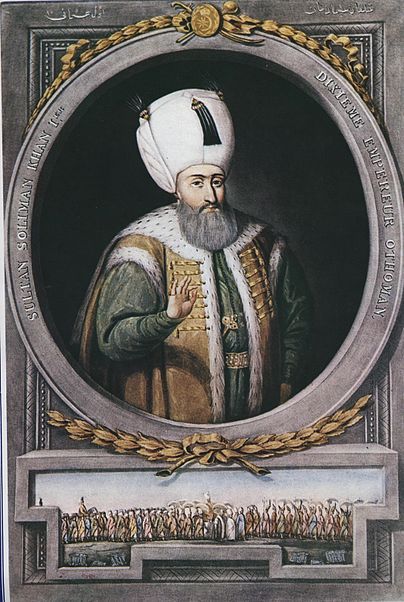

6 notes
·
View notes
Text
LISTA POSTACI
Sułtan Sulejman Wspaniały Wolny
Sułtanka Hürrem Wolna
Sułtanka Şah Wolna
Książę Cihangir Wolny
Sułtanka Mihrimah Wolna
Sułtanka Esmahan (Córka sułtanki Şah i Lütfi Paszy) Wolna
Rüstem Pasza Wolny
Lütfi Pasza (Mąż sułtanki Şah, ojciec sułtanki Esmehan) Wolny
Malkoçoğlu Balı Bey Wolny
Ayas Pasza Wolny
Hüsrev Pasza Wolny
Süleyman Pasza Wolny
Afife Hatun (Skarbniczka i zarządczyni haremu) Wolna
Firuze Hatun (Perska księżniczka, faworyta Sulejmana) Wolna
Mercan Ağa (Służący sułtanki Şah) Wolny
Fahriye Hatun (Służąca sułtanki Hürrem) Wolna
Sümbül Ağa Wolny
Şeker Ağa Wolny
Pargalı İbrahim Pasza Wolny
Sułtanka Hatice Wolna
Gülfem Hatun Wolna
Sułtanka Huricihan Wolna
Książę Osman Wolny
Książę Mehmed Wolny
Cihan Hatun (Faworyta księcia Mehmeda) Wolna
Książę Mustafa Wolny
Sułtanka Mahidevran Wolna
Taşlıcalı Yahya Bey (Poeta, przyjaciel księcia Mustafy) Wolny
Fidan Hatun (Służąca sułtanki Mahidevran) Wolna
Rümeysa Hatun (Faworyta księcia Mustafy) Wolna
Ayşe Hatun (Faworyta księcia Mustafy) Wolna
Książę Selim Wolny
Nurbanu Hatun Wolna
Dilşah Hatun (Faworyta księcia Selima) Wolna
Książę Bajazyd Wolny
Rana Hatun (Faworyta księcia Bajazyda) Wolna
Tuğrul Bey (przyjaciel Księcia) Wolny
Defne Hatun (Faworyta księcia Bajazyda) Wolna
Nigar Kalfa Wolna
Sułtanka Beyhan Wolna
Matrakçı Nasuh Wolny
Ferhad Pasza (Mąż sułtanki Beyhan) Wolny
Ebussuud Efendi (Sędzia Stambułu) Wolny
Barbaros Hayreddin Pasza (Admirał Imperium Osmańskiego, przyjaciel Mustafy) Wolny
6 notes
·
View notes
Text


This black coat with white stripes was first worn by Şehzade Selim (later Sultan Selim II) in the twenty-third episode of the fourth season of Magnificent Century.
It appeared again on Matrakçı Nasuh in the seventh episode of the second season of Tozkoparan İskender.
#Muhteşem Yüzyıl#Magnificent Century#Tozkoparan İskender#period drama#costume drama#historical drama#Selim II#Şehzade Selim#Şehzade Selim (Son of Hürrem)#Sehzade Selim#Matrakçı Nasuh#Nasuh Efendi#Matrakci Efendi#reused costumes#recycled costumes
7 notes
·
View notes
Photo




“My Pasha, Nasuh Efendi and the painter, Leo, are here.”
#Muhteşem Yüzyıl#Magnificent Century#mcedit#Hatice Sultan#Ibrahim Pasha#Pargali Ibrahim#Muhtesem Yuzyil#mc#wspaniałe stulecie#1x18#The Ghost of the Past#perioddramaedit#weloveperioddrama#period drama#historical drama#Awkward-sultana#I always thought this was hilarious#What a real world issue#COCKBLOCKED#funny
20 notes
·
View notes
Text
Matrakçı Nasuh Efendi Kimdir?
Matrakçı Nasuh Efendi Kimdir?
Türk, minyatürcü. Ayrıca matematik ve tarih konularında kitaplar da yazmış çok yönlü bir bilgindir. Doğum tarihi ve yeri bilinmiyor. Kâtip Çelebi ölüm tarihi olarak 1533′ü vermekteyse de, bunun doğru olmadığı bugün kesinleşmiştir. Çeşitli kaynaklarda onun 1547′den, 1551′den, 1553′ten sonra ölmüş olabileceği ileri sürülmektedir. Yaşamı üstüne bilgi de yok denecek kadar azdır. Saraybosna…
View On WordPress
0 notes
Note
Do you think that Nigar owed loyalty to anyone she backstabbed?
I don’t think Nigar owed anyone anything specially loyalty. Let’s start with the fact that they kidnapped the poor girl and forced her to serve them. Compared to like Daye hatun , Nigar cares less about these people. She is there because there is no other place to go. She is opportunistic more than anything else.
With Hurrem it wasn’t loyalty like Master/Slave one. It was friendship until Hurrem couldn’t trust Nigar anymore. Nigar didn’t support Hurrem because she wanted to gain but because she saw a potential in her and genuinely loved Hurrem. However, their relationship went back and forth and Nigar never betrayed Hurrem in Leo thing imo. Nigar does most things willingly unless Ibrahim shoves her into the wall (oops 🤭) but overall she does whatever she wants.
Now into Hatice thing. NO. Nigar didn’t chase Ibrahim, okay had some fantasies but at the end accepted her fate with Nasuh efendi. Ibrahim is the one who owned Hatice loyalty and he is the one who betrayed her. Put the blame on married men with power not the woman. Ik Nigar knows that Ibrahim is married to Hatice and shouldn’t build her happiness over another woman but like isn’t the “another woman” using Nigar for her own happiness making her serve them?
Imo Nigar actually started backstabbing in SO3 with Hurrem before that no. She backstabbed Hurrem for revenge and also Nigar at this point of her life was fucked up. But she didn’t owe Hurrem loyalty nor did Hurrem brought her because she expects loyalty. Hurrem at the end ,like everyone else, started using Nigar to provoke Hatice. Nigar in SO3 wasn’t being loyal to anyone she was surviving and seeking revenge.
9 notes
·
View notes
Note
Was Ahmed I aware that Kosem is plotting to become extremely powerful? This is shown by him separating her from Osman and him executin a damad. Was he afraid that she will be like Hurrem? Did he scold her?
According to Valier, Ahmed I was aware that Kösem had “ambitions” for her sons: whether she just wanted to save them from execution or she was already thinking of getting the throne for Mehmed, it is not known.
I don’t think Nasuh was executed for being Kösem’s favourite; about his execution, Tezcan says:
Contemporary Ottoman authors, Hasanbeyzade and Peçevi, state that the mufti was instrumental in Ahmed’s decision to execute Nasuh Pasha. Naima, an early eighteenth century author, provides further evidence, probably based on his now lost source, which suggests that there was enmity between the mufti and the grand vizier. Although the background of this enmity is not clear, Nasuh Pasha apparently wanted to get rid of Mehmed Efendi and asked his steward to murder him. The steward, however, informed the sultan, who eventually ordered Nasuh’s execution. Nasuh Pasha’s execution was definitely not simply the result of enmity between two powerful statesmen. Yet these references suggest that contemporaries perceived Mehmed Efendi to be powerful enough to bring about the execution of Nasuh Pasha, grand vizier and son-in-law of the sultan.
Börekçi adds that “Ahmed showed his determination to eliminate such manipulation of his trust even if, this time, he had to execute his own son in-law and the most important political ally of Kösem Sultan, who tried hard to stop her husband from taking such action.”
It almost sounds like Ahmed didn’t really want to execute Nasuh (and indeed, he had saved him twice from execution after his military failings, even though everyone in Istanbul was sure he was about to lose his head) but had to, especially after the müfti “meddled” in the situation.
23 notes
·
View notes
Text
MATRAKÇI NASUH (Tarihçi) - Türkçe Tarih
MATRAKÇI NASUH
Yazdığı eserlerde – çağdaşları gibi – kendi hayatı hakkında bilgi vermekten imtina etmiş olan Nasûh b. Abdullah el Priştevî ya da maruf ismiyle Matrakçı Nasûh’un ne zaman doğduğuna dair herhangi bir bilgi bulunmamaktadır. II. Bayezid devrinde Enderun’da talebe olarak bulunan Nasûh’un...
Devamını okumak için: https://turkcetarih.com/matrakci-nasuh/
Cemâlü’l-küttâb, Kemâli’l-hüssâb, Matrak, Matrakçı Nasuh Efendi, Matrakçı Nasûh., Minyatür, Nasûh b. Abdullah el Priştevî, Sicill-i Osmânî
#Cemâlü’l-küttâb#Kemâli’l-hüssâb#Matrak#Matrakçı Nasuh Efendi#Matrakçı Nasûh.#Minyatür#Nasûh b. Abdullah el Priştevî#Sicill-i Osmânî
1 note
·
View note
Text
Portrait of Kösem Sultan / Köszem szultána portréja
Origin and way to the palace
Kösem Sultan, according to most accounts, was of Greek descent, presumably born and raised on the island of Tinos until her abduction. Legend has it that she was called Anastasia and was the daughter of a priest, but there is no evidence to suggest this. It was fondly rumored for high-class concubines such as Kösem or even Hürrem that they were children of priests. The reasons for this are to be found in religious differences. The exact date of her birth is unknown, but she may have been roughly the same age as Ahmed I, so she was most likely born between 1587 and 1590.
There are several legends about how and when she got into the imperial capital. What is certain is that when she entered the harem, she was given the name Mahpeyker, which means moon-faced in Persian. Because the concubines were fondly named for their external or internal characteristics, her name suggests that Mahpeyker was a girl with a round face, light skin, and perhaps even blonde. Some say a Bosnian beylerbey presented the girl to the young sultan. According to another well-known legend, Mahpeyker was a servant of Handan Sultan, during Mehmed III's lifetime. That's how she got close to the young Prince Ahmed, with whom they fall in love and flirted with each other. As soon as Handan realized the relationship, she exiled the girl as their actions were not appropriate. Mahpeyker thus certainly spent the next few months in exile at the Old Palace.
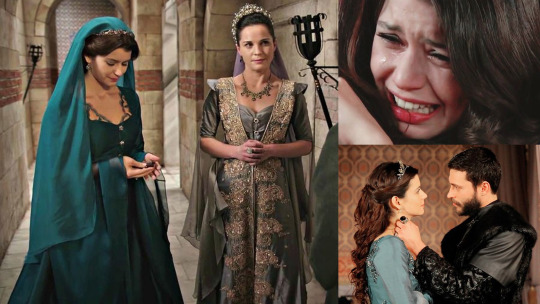
Rising
Mehmed III died in December 1603 and Prince Ahmed became the next sultan, as Ahmed I. The first few months of his reign were very chaotic, instead of him, his mother and teacher ruled as regents, and in addition, Ahmed fell ill with smallpox. From the spring of 1604, however, he increasingly took control and presumably recalled Mahpeyker from exile at that time as well, or it was at that time that the girl was given to him as a gift (depending on which legend is true). Mahpeyker soon became pregnant and in March 1605 gave birth to her first child, Mehmed. Mehmed was not Ahmed’s firstborn son, so Mahpeyker needed all her talents to save her son’s life. In any case, the fact that Ahmed had not executed his younger brother, the young Mustafa, could give her hope. The survival of Mustafa meant the end of the law of fratricide, which in turn guaranteed the survival of Mahpeyker's son.
Mahpeyher soon became the first woman of Ahmed's harem, as Handan Valide Sultan died in November 1605 after a long illness, and the mother of Ahmed's eldest son was not as loved by Ahmed as Mahpeyker. Based on harem documents, Mahpeyker received the rank of Haseki Sultan from the Sultan in late 1605 or early 1606, making it clear that the mother of his second son was Ahmed's favorite concubine. She also received a featured daily salary of 500 aspers, which later increased to 1,000 aspers. Based on reports, it can be attributed to this event that Mahpeyker decided to choose a new name for herself. Her new name was Kösem, which means "leader". The name made it clear that Kösem considered herself a leader. This is also supported by subsequent reports. The Venetian ambassador wrote Kösem as "a woman of beauty and wisdom who has a lot of talent, who sings excellently, and whom the Sultan loves more than anyone... Not everyone respects her, but in some matters, everyone listens to her word, for she is the Sultan's favorite, whom the ruler constantly wants to know by his side."
The former account suggests that there may have been tension between Kösem and the other consorts. We must admit though, that it would not be surprising, especially knowing that Mahfiruze was the mother of the firstborn prince, yet Kösem got the rank of Haseki Sultan and she clearly rose above the other concubines. Another account also supports this, as the Sultan once beat a concubine for irritating Kösem. True, after beating the woman, he ordered the doctors of the harem to treat her properly because of the old love between them. More likely, however, contrary to legend, this consort was not Mahfiruze, but a lesser important and influental woman.
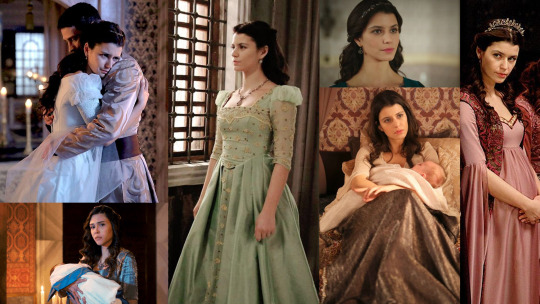
The chief consort
Kösem and Ahmed had a great number of children and from the birth-date of the children, we can conclude that Ahmed was mainly having sex with other concubines when Kösem was pregnant. In addition, it appears that for a few years after the birth of Prince Mehmed, Ahmed had a monogamous relationship with Kösem or he was careful not to have children with others. This is suggests by the fact, that after the birth of Ahmed’s first three children (Osman, Gevherhan, Mehmed) who were born from three mothers, from 1605 to 1609 only Kösem gave birth to children: Ayşe, Fatma and Hanzade Sultanas arrived in quick succession. From then on, after 1609 Ahmed regularly slept with other concubines from whom his children were also born. Kösem finally got pregnant again at the end of 1611, so then Ahmed called her first concubine Mahfiruze again. In 1612 thus two more princes were born from the two concubines, Murad and Bayezid. After the birth of Bayezid, Mahfiruze presumably passed away, so Kösem remained the only influential woman in the harem. Maybe the increase in her salary happened this time. Kösem gave birth to her last two children in 1614 and 1615, so the dynasty was expanded by two more princes, Kasim and Ibrahim.
The fact that Kösem had many sons and did not own the eldest son made it clear that she had to fight to keep Prince Mustafa, Ahmed's brother alive. For if Prince Mustafa survives, the succession system will change forever and her sons may survive. Even the ambassadors remembered her actions. Kösem knew the nature of Sultan Ahmed well, so she knew exactly what might affect the sultan. Ahmed tried to execute his brother three times before giving up permanently and leaving him alive. It is not known exactly what convinced the Sultan, but the constant argument of Kösem for keeping Mustafa alive certainly helped a lot. Ahmed was a very religious man who believed in fate and thought he was a chosen one, for he found no other explanation for the fact that, as a not first-born son, he eventually ascended the throne. Kösem taking advantage of this argued that only Allah has the right to choose the next ruler, and as Ahmed did not become a sultan either as a first-born, he must show compassion for his non-firstborn brother as well. Perhaps Kösem also pointed out that as soon as Sultan Mehmed III intervened in fate and executed his child, he himself soon died. Whatever Kösem and other supporters of Mustafa said, Ahmed eventually left his brother alive but did not officially change the system of succession. He left the decision to Allah.
Kösem tried to influence Ahmed in other matters as well, but she knew exactly how far she could go. For Ahmed did not want to be controlled by women, Kösem tried only carefully to control the Sultan. Although many believe that Kösem was influential in political fields already in Ahmed’s life, this is certainly not true. Kösem was not politically influential during Ahmed’s reign, only in the harem did she enjoy prominent influence thanks to her Haseki rank and the support of the chief eunuch, Haci Agha. The only politically significant step of Kösem was to push the Sultan to marry off their firstborn daughter, Ayşe to one of her faithful supporters, Nasuh Pasha. However, she could not enjoy the benefits of the marriage for long, as Nasuh Pasha was executed by the sultan soon after.
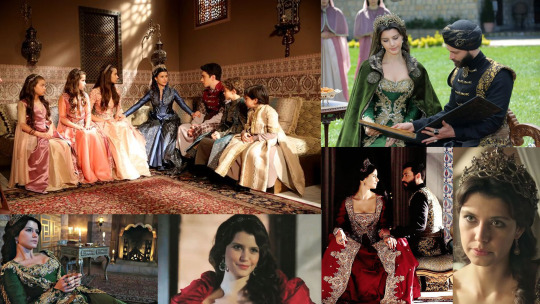
The tragedy
Sultan Ahmed had been a sick man all his life, but by 1617 his illness had become very serious, the sultan must have been in constant pain. There are malicious, completely unbelieving rumors that Kösem was behind Ahmed's illness. However, this is simply not true and cannot be true. Kösem was the one who lost as much as possible with Ahmed’s death. Two princes also stood in front of her sons for the throne, Ahmed's brother, Mustafa, and Ahmed's firstborn son, Osman. Osman lost his mother around 1612, and Kösem wanted to turn the situation to her advantage. She believed that raising Osman as her own son from then on could save the lives of her own children if Osman would sat on the throne one day. That is why Kösem spent a lot of time with Osman, taking him to carriage rides regularly when she visited Safiye Sultan in Old Palace with her own son, Mehmed. However, Ahmed knew Kösem well, he knew what her intentions were, so he forbade her to meet or even talk to Osman and his younger brother (Bayezid most probably).
Ahmed's condition was already in crisis in November 1617, and the 27-year-old sultan finally died on November 22, 1617. His death caused chaos, as the members of the divan did not know who to put on the throne. Both possible candidates were completely unfit to rule. Prince Mustafa was mentally ill as a result of many years of solitary confinement, he was like a small child in mind; Prince Osman was only 13 years old and was without a strong mother who could support and guide him. Eventually, under the pressure of Haci Agha and Seyhülislam Efendi, Prince Mustafa was made Sultan, hoping that his condition would improve if he could be among people again. With the accession of Mustafa, all of Ahmed's concubines, including Kösem, and their daughters retreated to the Old Palace. However, her sons were separated from her and all the princes were kept in solitary confinement in the kafes. We can only imagine how much pain it could have been for a mother to lose her partner, being torn apart from her sons. Kösem was also very worried about the lives of her sons.
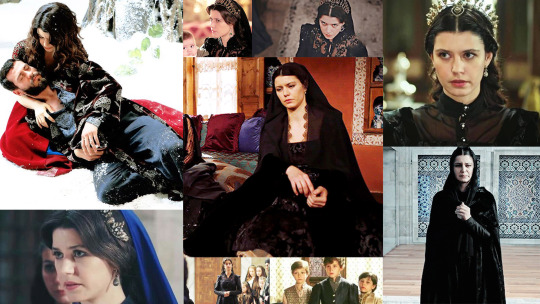
False relief
Due to the unfitness of Sultan Mustafa, he was dethroned and locked up again in 1618. The new sultan became Osman II. The sons of Kösem were still locked up, but Osman did not forget how Kösem cared for him in his childhood. The young sultan regularly visited Kösem at the Old Palace. Based on these, maybe Kösem thought that her sons are safe.
However, Sultan Osman was surrounded by bad advisers who only cared about their own interests. Due to this and the unstable political situation, Osman II executed his brother, Prince Mehmed, in 1621. Osman was not liked by his soldiers, his supporters were also unpopular, but Prince Mehmed was a really good candidate for being a sultan with a strong mother, like Kösem. The young sultan Osman feared deposition and it was certainly this fear that drove him into the fratricide. But with this choice, he also signed his own death sentence. Osman was dethroned by the Janissaries in 1622 and was brutally executed. The main supporter of the dethronement was the mother of Sultan Mustafa, Halime. Some say from the background, Kösem also supported Halime. There is no evidence for this, but the assumption seems quite logical.
After the assassination of Osman II, Mustafa and his mother, Halime, reigned again. However, the second sultanate of Sultan Mustafa was no more successful than the first. The statesmen and people could not forgive the brutal execution of Osman, so Mustafa was once again deposed and in 1623 the time of Kösem came.
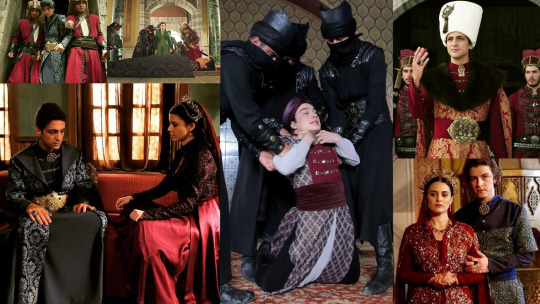
The regent
After the dethronement of Mustafa, the barely 11-year-old Prince Murad became the new Sultan, as Murad IV. However, given his young age, his mother, Kösem, became the regent instead. It is clear from her correspondence with the Grand Vizier that Kösem wanted to rule as a regent by accompanying her son to every event so that she would appear in the audience room of the divan with him also. She made this request to the Vizier, who, in turn, did not allow Kösem to do so, citing traditions and asked her to forget this. Kösem at that time agreed to this and worked from the background. Every report of this time talks about Kösem in a very nice way. They point out that she is not at all like Mustafa I’s mother, as she is a smart, well-versed politician, a wise and thoughtful woman who has already demonstrated in Ahmed’s life how strong a spirit lives in her.
With so much pain behind her, with Murad’s accession to the throne, she was finally able to meet her sons again and she believed their lives would finally continue in a calmer period. Kösem and her sons could not live together for almost six years though, presumably only met during the holidays. This certainly affected her relationship with her sons. Murad was a difficult child to handle, and several letters of Kösem have survived in which she complains to the Grand Vizier about how much she does not have the strength to fight with Murad and how much he does not listen to her words, and sometimes he even refuses to see her for days. In addition to the wedge of isolation between them, their similar personalities did not help much either. They were both leading individuals, with a very strong will, so they had a hard time getting along with each other. They argued with each other many times, after which Kösem was the one who wanted to reconcile. After one of their big quarrels, for example, she gave Murad a horse, and at other times she organized a huge ceremony for him. In addition, Kösem has regularly expressed her concern about Murad’s health, suggesting that perhaps Murad was already struggling with health problems at the time, as was his father.
Kösem although ruled for a very long time, there is almost no information about her regency. It is so certain that Kösem has always enjoyed the support of the Janissaries throughout her life. Statesmen came and went but the Janissaries always stood by her. Why? Kösem seemed like a sure point in chaotic times, and because on a delicate issue, she sided with the Janissaries immediately after the accession of Murad. With each accession to the throne, the sultan distributes money among his soldiers, but the statesmen did not want to fulfill it when Murad ascended the throne. They thought that this money had been paid too many times in the last few years, given that the sultans just came after each other in a short row. Kösem, however, did not agree with this and paid the money for the Janissaries. And in gratitude for this — and certainly for the money later delivered to them — they stood by the side of Kösem throughout her life.
About Kösem's political decisions, little has survived. Her remaining letters make it clear to us that she worked closely with the pashas and the decisions were discussed together. The leading pashas wrote their letters directly to her, which also proves that every thread ran together in the hands of Kösem. In essence, she was actually steering instead of her son, not along with her son.
From Ahmed's death, the empire gradually fell into anarchy, which couldn't be stopped even by the otherwise fairly well ruling Kösem. They lost several important areas and tried in vain to recapture them without success. Furthermore, Abaza Mehmed Pasha, who revolted after the execution of Osman II, despite the fact that everyone was punished who were accountable for the murder, refused to recognize Murad as his new ruler and continued his rebellion. Nor could this be suppressed by the pashas sent after him. To make matters worse, in 1625 a plague broke out in the capital and killed more than a hundred thousand people. Then in 1628 Murad also became seriously ill, lying in bed for weeks. His exact illness was not revealed, but some say that was when his epilepsy began. The only good thing happening in that year was the fact that they were able to capture Abaza Mehmed Pasha and stop his rebellion.
Kösem tried to maintain the peace of the empire to her best efforts, and for this, she was forced to turn a blind eye to certain things. Such was the case with growing corruption. This generated a lot of controversy between her and her son. For Murad had peculiar ideas of reign, his role model was Selim I, who held everything in his own hands and ruled the empire with iron tightness. In addition, Kösem herself gave big influence and power to the pashas she favored, which has provoked resentment from many. For example, her son-in-law, Fatma's husband, Hafiz Ahmed Pasha, took up an important position as a Janissary officer, which was too much even for the Janissaries who otherwise loved Kösem.

Valide Sultan
In 1632, after the appointment of Hafiz Ahmed Pasha, a Janissary revolt took place, during which the rebels executed the Grand Vizier and the close friend of Sultan Murad, Musa Çelebi. As a result, in May 1632, Murad took control and resigned his mother from the regent position, and began to rule himself. Kösem did not object, she stood aside, but she tried to help her son, to show him the way. Murad didn't appreciate it though in the slightest and didn't listen to his mother's advice. Murad was compulsively trying to keep his mother away from politics, and it is clear from his actions that he was disturbed by his mother’s great influence, the fact that in recent years his mother has had much more power than him, the sultan. That is why, as soon as he took power Murad tried to replace his mother's men, such as his own brother-in-law, Hafiz Ahmed Pasha, who had already been mentioned. With this he could withdraw from his mother's influence to begin his absolute rule. The relationship between the two of them was probably marked by the Janissary rebellion of 1632 forever and because of this, they could not get closer to each other later either. Kösem in the years of Murad’s reign, thus essentially functioned only as a valide sultan, administering the harem and dealing with her charitable projects.
Kösem had a good sense of winning people. She often distributed donations to those in need, and visited prisons every year, where she paid the debt of those who were imprisoned for debt; she helped poor families to marry off their daughters; she freed her own slaves after two years of service and took care of their marriages. Her charity is undoubted, but it is also important to mention that she regarded her former servants as a kind of spies. She kept their husbands in check through the women who were extremely loyal to her. Thus, in addition to helping many with a good heart, in some cases, these charitable acts also served her own interests. This was not uncommon anyway, every other sultana used these marriages to serve their own interests.
Kösem was worried a lot for her son, as Murad has divided the people a lot. After many years, he was the first sultan to lead a successful campaign for which the people loved him. At the same time, he ruled with excessive cruelty and wrote hypocritical laws. He sentenced to death, for example, those who drank despite the alcohol ban regulation while he himself became increasingly immersed in alcoholism. In addition to Murad’s alcoholism, he was certainly paranoid and depressed, due to his childhood traumas and the fact that his sons died in a row. Some also blame Kösem for the early death of Murad’s sons, but there is no evidence to that. In his writings, Evliya Çelebi clarifies that all of Murad’s sons were born in poor health and therefore died shortly after their birth.
Even though Murad didn’t really heed the suggestions his mother, Kösem never gave up and tried to support her child in everything. Thus, for example, when Murad was away from Istanbul, she thoroughly reported that someone had not followed his instructions. She did so even when they did not want to carry out an execution-order issued by Murad.
Despite the fact that Murad only was alive thanks to the abolishing of the law of fratricide, he himself decided that the old system should be brought back. For this reason, after his successful campaign in Revan, he executed his two half-brothers, Bayezid and Suleiman, in 1635, and three years later, after his campaign in Baghdad, his full-brother, Prince Kasim. The life of the youngest brother, Ibrahim, was saved only by the prince's troubled mind and the supplication of Kösem. The fact that Murad wanted to get rid of all his brothers may point to two things. Either he had completely lost his sanity and wanted the end of the dynasty, or he had at least one living son during this period for whom he wanted to clear the way.

Second regency
Murad suffered serious injuries during the campaign in Baghdad, and his alcoholism, cirrhosis caused by his alcoholism, and his chronic illness all worsened his situation. Some say Murad ordered the execution of Ibrahim while dying, but Kösem prevented him from doing so. Either way, in February 1640, Sultan Murad died in the Revani Pavilion, exactly where he had executed his younger brother, Kasim not long before. By his death, the only man in the dynasty alive was his younger brother, the mentally unstable Ibrahim. Ibrahim was completely unfit to rule, like his uncle Mustafa I, he himself struggled with mental problems. However, unlike Mustafa, Ibrahim was paranoid insane. When he was told that his brother was dead, he could not believe it and refused to sit on the throne until he could examine his brother's dead body himself.
In the first years of Ibrahim's reign, Kösem was able to handle the Sultan well and gave him concubines to deal with them instead of other kinds of stuff. Meanwhile, she herself ruled with the Grand Vizier, Kemankeş Kara Mustafa Pasha, instead of his son. Although Kösem and Kemankeş Kara Mustafa Pasha did not like each other and even they constantly rivalized, they still ruled excellently together for the sake of the empire. This regency may have been easier than the previous one, for the empire was relatively at peace, and Kösem as an experienced, mature woman could easily rule. In addition to state affairs, she also tried to oversee the affairs of the harem in all aspects. Thus, for example, she had a confrontation with Murad IV's Haseki, Ayşe. Ayşe wanted to marry her daughter, Esmehan Kaya, to the Silahdar Mustafa Pasha, to whom Murad had promised the girl. Kösem, however, chose someone else, from her own trusted men. The debate between the two women went very far and even Kaya herself did not want to marry Kösem's chosen one, but Kösem did not give up and in 1644 forced her - otherwise favorite - granddaughter to marry the very old Melek Ahmed Pasha.
Over time, Ibrahim came under the influence of a certain Cici Hoca and rebelled against his mother’s rule. Cinci Hoca was a religious leader in occult sciences who took advantage of the sultan’s mental problems. As a result, the Sultan executed his Grand Vizier in 1644 and exiled his mother. He originally intended to send his mother to the island of Rhodes, but eventually, his concubines persuaded him to send him only to another palace. Kösem spent the next few years there in exile, but during that time she also corresponded regularly with the statesmen and tried to keep everything under control. She probably also wrote her well-known letter to Hezarpare Ahmed Pasha here, saying, "In the end, he would leave neither you nor me alive and we would lose control of the state again, thereby destroying our society." The relationship between Ibrahim and Kösem deteriorated so much that Ibrahim wanted to punish his mother at all costs. For this, he deprived Ayşe, Fatma, Hanzade, and Esmehan Kaya, of all their possessions and forced them to serve his new wife. So basically he punished Kösem through her daughters and favorite granddaughter.
Ibrahim's insane rule threatened more and more people. The sultan executed people for almost no reason and gave high positions to those who were completely unfit. The situation deteriorated to the point that in 1647 Kösem and the new Grand Vizier, Salih Pasha together with the Seyhülislam Abdürrahim Efendi, tried to depose Ibrahim, but they failed. The following year, both the Janissaries and the Ulema joined the rebellion, and on August 8, 1648, the mad sultan was easily deposed and imprisoned, and his followers were removed from their positions. They had to decide the fate of Sultan Ibrahim soon, but it was not easy. There used to be a mad sultan who was simply closed up after his dethronement, so this could have been possible in the case of Ibrahim also. However, Ibrahim caused pain to too many, executed too many innocent, and simply had too many supporters to keep him alive.
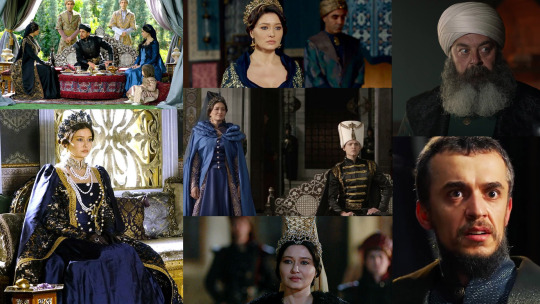
The broken mother
Everyone demanded the execution of Sultan Ibrahim. Kösem Sultan met with the statesmen at Topkapi Palace to discuss with them what Ibrahim's fate should be. They negotiated for hours, but Kösem all along refused to gave Ibrahim's eldest son, Mehmed to the rebels, so they could not name him sultan. Eventually, the statesmen convinced Kösem, as she was forced to realize over time that her son posed a potential threat to everyone: her, her children, statesmen, soldiers, the entire empire. Kösem didn’t have much choice but to agree to the execution of her son, yet many of the people nowadays condemned her decision. However, we must recognize that whatever did or said Kösem, Ibrahim would have been executed anyway. Kösem, however, with this decision, cared about the interests of the empire, she acted as a ruler and not as a mother. It was a decision similar to the execution of Prince Mustafa in the case of Suleiman I. A true ruler is not only a father or mother to their children but also their superior. On August 18, 1648, Sultan Ibrahim was executed and his eldest son, Mehmed IV became the new sultan.
Although Kösem's decision was logical and the only good decision for the empire, she herself seems to broke under the weight of the decision. After the execution of Ibrahim, she announced her retirement to the Old Palace, but the statesmen did not allow her. They convinced her that the empire needed her as regent, once again, for the last time. Mehmed was only 7 years old at the time, and his mother was in his early twenties, too young to act as a regent. Kösem accepted the ask of the pashas and again she became the regent of the empire. From her actions and the changes in her personality, we can conclude that it has become her obsession that she is the only one who can rule the empire properly. After the tragedies that befell her, it is perhaps not surprising that such a mental problem has emerged.
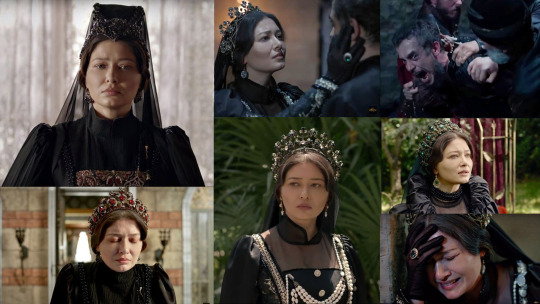
The tyrant
Although the statesmen themselves asked Kösem to rule, over time they had to realize that this Kösem was not the woman they had know before. Nonetheless, they expected Kösem to teach Turhan Hatice Sultan and the little Sultan Mehmed how to handle political affairs properly. So they would have expected a kind of training from Kösem, but instead of it, she wanted to decide everything herself, dismiss the statesmen who contradicted her.
More and more people began to debate the right of Kösem for the ruling, one of her well-known divan speech is also from this period. Then Kösem accused Grand Vizier Sofu Ahmed Pasha that he wanted to kill her, then continued, "Thank God I saw four rulers and I ruled for a long time myself also. The world will neither collapse nor reform with my death." Although her speech suggest that she tried to minimize her own influence and importance, she did not act like this otherwise. At the same divan meeting, Kösem confronted with Karaçelebizade Abdülaziz Efendi for not fulfilling the order given by the sultan immediately. Instead of fulfilling it he asked the sultan, "My dear, who taught you to say such things?". Kösem said that such a derogatory speech towards the sultan is unacceptable, and anyway, how did Karaçelebizade Abdülaziz Efendi think that it was not the sultan who invented what he said?! It is clear, then, that Sultan Mehmed was seen by everyone as a kind of toy. Kösem used the child as her own puppet, and her opponents recognized this exactly, so they were fought with her through not fulfilling her words coming from the sultan.
She also ignored Mehmed's mother, Turhan Hatice in the harem. She did not give the general respect she deserved, did not let the young woman to control of anything or rule the harem, which actually as a valide sultan, was her right. But Turhan did not give up. The harem was torn in two parts, to the supporters of Kösem and the supporters of Turhan Hatice. Both sides had their own chief eunuch, true that the more influential eunuch, Suleiman Agha was on Turhan's side. It says a lot that even then they were not able to defeat Kösem within the harem. People did not know whose instructions to follow, which caused immense chaos within the harem. And although the title of Valide Sultan rightfully belonged to Turhan Hatice as the mother of the Sultan, the colloquial language referred to her only as "small valide," while Kösem was "great valide." Kösem also kept the valide sultanas usual 3,000 aspers daily salary for herself, while Turhan was only allowed to get 2,000 aspers for a day.
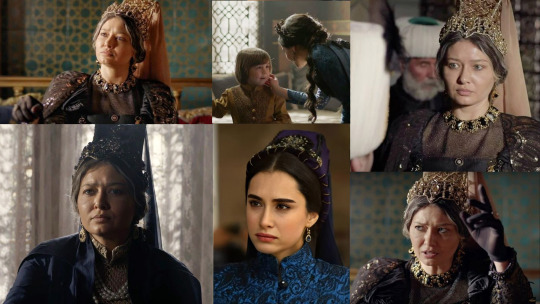
The inevitable end
Over time, the strife between Kösem and the statesmen escalated to the point that, with the support of Turhan Hatice, the statesmen tried to remove Kösem from her position. Kösem in response planned to dethrone Sultan Mehmed IV and put her other grandson on the throne instead. To do this, she wanted to let the Janissaries into the palace to carry out the coup at night, which is why she left the gates of the harem open for the night. However, her plan was revealed to her enemies, according to some by a servant named Meleki Hatun. Others said Kösem did not want to dethrone and execute Mehmed, she just wanted to scare him; again others think Kösem did not plan anything, just her enemies had enough of her and they came up with a story to justifying their rebellion against Kösem. However, the best known and most supportive story is still that Kösem wanted to strip Mehmed, so I continue on this line.
Thus, as soon as the men of Kösem opened the gate on September 2, 1651, the people of Turhan Hatice, led by Chief Eunuch Uzun Suleiman Agha, closed it and sent an execution squad to the residence of Kösem. In addition to the support of all existing statesmen, Turhan even had the support of the Spahis during the events, while Kösem was only supported by some Janissary corps. Turhan's people knocked on the door of Kösem when they arrived at her apartment, Kösem thought her own people had come, so she shouted out at them, "Have you come?". For this, however, instead of the voice of the Janissaries, she heard the voice of the eunuch Suleiman Agha, from which she understood that she lost and started to flee. It’s not exactly known how she got out of her apartment or did she even get out from there at all because the descriptions don’t match. Some said she hid in a closet inside her apartment, others said she tried to get to the Janissaries, but she couldn’t get through the closed gate, so she finally hid in the room next to the gate. During her escape, some of the concubines also tried to rush to her aid and blocked the execution squad, and an older woman shouted that she was Kösem Sultan to gain time for her. She tried in vain, for though the executioners did not know the face of Kösem, Suleiman Agha did, so they quickly continued their way after Kösem.
Eventually, Kösem hid in a closet from which the edge of her dress protruded, revealing her hiding place. When they found her, she threw money at his executioners, trying to buy her freedom, but she had no chance against Turhan's loyal men. Legend has it that when the men tried to hold down the valide they ripped out of her ears the diamond earrings she received from Sultan Ahmed; her clothes were also torn as they tried to take away the precious ornaments from it. Even beyond her sixties, Kösem fought very hard against her executioners but in the end they overcame her. Some say she was strangled with her own hair, others said with a curtain. After the first strangulation attempt, she was still alive but did not survive the second one. We don't know who was the one who decided that Kösem Sultan should die. The execution may appear to have taken place lawfully, based on the fetwa of Seyhülislam. However, the temporality is somewhat disturbed by the fact that the original Seyhülislam was replaced by one of Turhan’s trusted men at the same time when the execution took place. Precisely because of this, and because of the unusual brutality of the execution, there may be the possibility that perhaps the execution of Kösem was not originally planned, but the events slipped out of control, and in the heat of the moment the guards executed her. To legalize the events, they produced a fetwa with the new Seyhülislam soon after.
To prevent any resistance, Turhan Hatice and her men removed all statesmen who would have endangered them during the night. And the ones who resisted were forced to surrender with a fetwa. Eventually, they succeeded in blaming the Janissaries for the execution, so in the end, the Janissaries, the main supporters of Kösem, were used as scapegoats. The leaders of the Janissaries were executed.
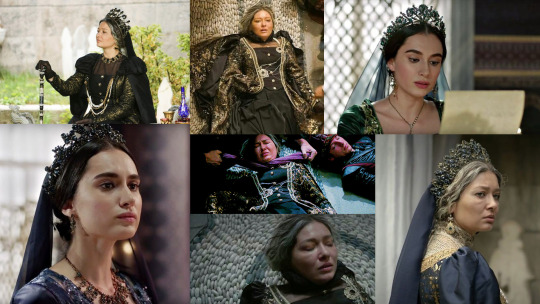
Legacy
Kösem was buried on September 3 in the complex of Sultan Ahmed. She lies between her beloved Sultan and eldest daughter, Ayşe. The palace did not give an official order on mourning, still, the people of Istanbul decided on their own to close all shops for three days to pay their respects to the deceased Kösem Sultan. Many loved her for her charities, but the fact that the people did not hate Turhan Hatice either, (actually they loved her also) suggests that she was not blamed for Kösem Sultan's death.
Kösem Sultan can be considered as the last classical Haseki Sultan and the only Valide Sultan who served as a regent three times, along with three different sultans. For a total of 27 years and 11 months, she had the third-longest reign in the history of Ottoman Empire as a Valide Sultan. She has spent a great amount of money from her amazing wealth to help the ones in need throughout her life. Although she has had a smaller complex built, she has spent less on construction than her predecessors. Rather, she tried to help those in need in a smaller, less spectacular way. According to some accounts, she went so far with her donations that when she overspent herself and in vain asked her son for help, she sold her jewelry so that she could continue what she had planned.
She is almost the only sultana who, when characterized by contemporary ambassadors, emphasized not primarily her beauty but her intelligence, prudence, and strength. Kösem Sultan was the sultana who broke the highest, who could have been at the top for a long time, but from the great heights, she finally fell down and became the only murdered valide sultana ever.
Kösem Sultan had several titles during her life: Naib-i Sultanat (regent of the Ottoman Empire), Umin al-Mu'minin (mother of all muslims), Büyük Valide Sultan (great Valide Sultan), Valide-i Sehide (martyred mother), Valide-i Maktule (murdered mother), Valide-i Muazzama (magnificent mother).
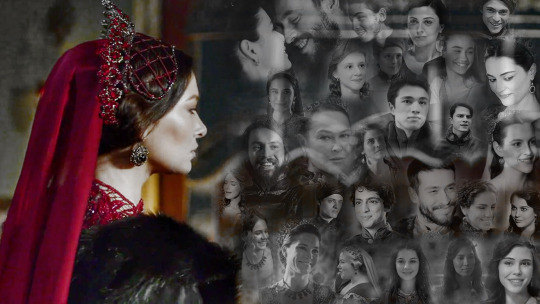
Used sources: Ö. Kumrular - Kösem Sultan: iktidar, hırs, entrika; C. Finkel - Osman’s Dream: the History of the Ottoman Empire, L. Peirce - The Imperial Harem; M. P. Pedani - Relazioni inedite; N. Sakaoğlu - Bu Mülkün Kadın Sultanları; B. Tezcan - Searching for Osman: A Reassessment of the Deposition of the Ottoman Sultan Osman II (1618-1622); Y. Öztuna - Sultan Genç Osman ve Sultan IV. Murad; G. Börekçi - Factions and Favorites at the Courts of Sultan Ahmed I and His Immediate Predecessors; F. Davis - The Palace of Topkapi in Istanbul; G. Börekçi - A Queen Mother at Work: On Handan Sultan and Her Regency during the Early Reign of Ahmed I; . Faroqhi - The Ottoman Empire and the World; C. Imber - The Ottoman Empire 1300-1650; F. Suraiya, K. Fleet - The Cambridge History of Turkey 1453-1603; G. Piterberg - An Ottoman Tragedy, History and Historiography at Play; F. Suraiya - The Cambridge History of Turkey, The Later Ottoman Empire, 1603–1839; Ö. Düzbakar - Charitable Women And Their Pious Foundations In The Ottoman
* * *
Származása és útja a palotába
Köszem szultána a legtöbb beszámoló szerint görög származású volt, aki feltehetőleg Tinos szigetén született és nevelkedett egészen elrablásáig. A legendák szerint, Anastasiának hívták és egy pap lánya volt, azonban erre utaló bizonyíték nincs. Előszeretettel híresztelték a magasra törő ágyasokról, mint amilyen Köszem vagy akár Hürrem volt, hogy papok gyermekei voltak. Ennek okai a vallási különbségekben keresendőek. Pontos születési ideje nem ismert, ám I. Ahmeddel nagyjából egy idős lehetett, így 1587-1590 között születhetett a legnagyobb valószínűséggel.
Több legenda is létezik arra vonatkozóan, hogy hogyan és mikor került a birodalmi fővárosba. Annyi bizonyos, hogy a hárembe kerülésekor a Mahpeyker nevet kapta, mely jelentése perzsául hold-arcú. Mivel az ágyasokat előszeretettel nevezték el külső vagy belső tulajdonságaik alapján, neve valószínűsíti, hogy Mahpeyker kerek arcú, világos bőrű lány volt, sőt talán szőke is. Egyesek szerint egy bosnyák beglerbég ajándékozta a lányt az ifjú szultánnak. A másik jól ismert legenda szerint Mahpeyker Handan szultána szolgálója volt még III. Mehmed életében. Így kerülhetett közel az ifjú ágyas Ahmed herceghez, akivel egymásba szerettek és flörtöltek. Amint Handan rájött a viszonyra, a lányt száműzte, hiszen nem volt illendő a tettük. Mahpeyker így minden bizonnyal valamennyi időt a Régi Palotában töltött száműzetésben.

Felemelkedés
III. Mehmed 1603 decemberében meghalt és Ahmed herceg lett a következő szultán, I. Ahmed néven. Uralkodásának első néhány hónapja igen kaotikus volt, helyette anyja és tanítója uralkodott régensként, majd Ahmed himlőt is kapott. 1604 tavaszától azonban egyre inkább saját kezébe vette az irányítást és feltehetőleg ekkor hívta vissza Mahpeykert is a száműzetésből, vagy ekkor ajándékozták neki a lányt (attól függően mely legenda az igaz). Mahpeyker hamarosan várandós lett és 1605 márciusában életet adott első szülött gyermekének, Mehmednek. Mehmed nem Ahmed elsőszülött fia volt, így Mahpeykernek minden tehetségére szüksége volt, hogy fia életét megóvja. Mindenképpen reményt ébreszthetett benne a tény, hogy Ahmed trónralépése után nem végeztette ki édesöccsét, a kisgyermek Musztafát. Musztafa életben maradása a testvérgyilkosság törvényének megingását jelentette, amely pedig Mahpeyker fiának életben maradását is garantálta.
Mahpeyher hamarosan Ahmed háremének első asszonya lett, Handan Valide Szultána ugyanis 1605 novemberében hosszas betegség után elhunyt, Ahmed legidősebb fiának anyja pedig nem érhetett fel Mahpeykerhez. A hárem dokumentumok alapján Mahpeyker 1605 végén vagy 1606 legelején kapta meg a szultántól a Haszeki Szultána rangot, amivel Ahmed egyértelművé tette, hogy második fiának anyja a kedvenc ágyasa. Rangjához kiemelt, 500 asperes napi fizetést is kapott, mely később 1000 asperre növekedett. Követi beszámolók alapján ehhez az eseményhez köthető, hogy Mahpeyker úgy döntött új nevet választ magának. Új neve a Köszem lett, melynek jelentése "vezető". A név egyértelművé tette, hogy Köszem magát vezéregyéniségnek tartotta. Ezt a követi beszámolók is alátámasztják. A velencei követ úgy írt Köszemről, mint "a szépség és okosság asszonya, aki nagyon sok tehetséggel bír, kiválóan énekel és akit a szultán mindenkinél jobban szeret... Nem mindenki tiszteli, azonban bizonyos ügyekben mindenki hallgat a szavára, hiszen ő a szultán kedvence, akit állandóan maga mellett akar tudni az uralkodó."
Az előbbi beszámoló sejteti, hogy talán feszültség lehetett Köszem és a többi ágyas között. Valljuk be ez nem lenne meglepő, különösen ismerve, hogy Mahfiruze volt az elsőszülött herceg anyja, mégis Köszem viselhette a Haszeki szultána rangot és egyértelműen minden téren a többi ágyas fölé magasodott. Egy másik beszámoló szintén alátámasztja ezt, ugyanis a szultán egyszer megveretett egy ágyast, amiért az irritálta Köszemet. Igaz, miután megverette a nőt, elrendelte, hogy kezeljék a hárem orvosai megfelelően, a köztük lévő régi szerelem miatt. Valószínűbb azonban a legendákkal ellentétben, ez az ágyas nem Mahfiruze volt, hanem egy jelentéktelenebb nő.

A főágyas
Köszem és Ahmed igen sok gyermeket nemzettek és a gyermekek születési éveiből arra következtethetünk, hogy Ahmed főleg akkor hált más ágyasokkal, mikor Köszem terhes volt. Emellett úgy tűnik, hogy Mehmed herceg születése után néhány évig Ahmed vagy monogám kapcsolatban állt Köszemmel vagy odafigyelt, hogy másoknak ne nemzzen gyermeket. Erre enged következtetni, hogy Ahmed első három gyermekének (Oszmán, Gevherhan, Mehmed) három anyától való születése után 1605-től 1609-ig nem született mástól gyermeke, csak Köszemtől: Ayşe, Fatma és Hanzade szultánák gyors egymásutániságban érkeztek. Innentől kezdve Ahmed rendszeresen fogadott más ágyasokat is, akiktől gyermekei is születtek. Köszem végül 1611 végén újra teherbe esett, ekkor Ahmed újra hívatta első ágyasát Mahfiruzét. 1612-ben így két újabb herceg jött világra a két ágyastól, Murad és Bayezid hercegek. Bayezid születése után Mahfiruze feltehetőleg elhunyt, így Köszem maradt az egyetlen befolyásos nő a háremben. Köszem utolsó két gyermeke 1614-ben és 1615-ben jöttek világra, így újabb két herceggel, Kasimmal és Ibrahimmal bővült a dinasztia.
A tény, hogy Köszemnek sok fia volt és nem övé volt a legidősebb fiú, egyértleművé tette, hogy küzdenie kellett Musztafa herceg, Ahmed öccsének életben tartásáért. Ha ugyanis Musztafa herceg életben marad, az öröklés örökre megváltozik és fiai életben maradhatnak. Köszem küzdelméről még a követek is megemlékeztek. Köszem jól ismerte Ahmed szultán természetét, így pontosan tudta mivel hathat a szultánra. Ahmed háromszor próbálta meg kivégeztetni öccsét, mielőtt végleg feladta és életben hagyta volna. Nem tudni, hogy pontosan mi győzte meg a szultánt, de Köszem állandó érvelése Musztafa életben hagyása mellett minden bizonnyal sokat nyomott a latba. Ahmed igen vallásos férfi volt, aki hitt a sorsban és úgy gondolta, ő maga kiválasztott, nem talált ugyanis más magyarázatot arra, hogy sokadszülött fiúként végül ő került a trónra. Köszem ezt használta ki, és úgy érvelt, hogy csak Allahnak van joga kiválasztani a következő uralkodót, Ahmed pedig mint aki maga sem elsőszülöttként lett szultán, könyörületet kell mutasson szintén nem elsőszülött testvére iránt. Talán Köszem arra is rávilágított, hogy amint III. Mehmed szultán beleavatkozott a sorsba és kivégeztette legesélyesebb gyermekét, maga is hamarosan meghalt. Akármit is mondott Köszem és Musztafa többi támogatója, Ahmed végül életben hagyta öccsét, azonban nem változtatott a trónöröklési sorrenden hivatalosan. Allahra hagyta a döntést.
Köszem más ügyekben is igyekezett befolyásolni Ahmedet, ám pontosan tudta, meddig mehet el. Ahmed ugyanis nem szerette volna, ha nők irányítják, így Köszem csak óvatosan igyekezett irányítani a szultánt. Bár sokan úgy tartják, hogy Köszem mozgatta a szálakat már Ahmed életében is, minden bizonnyal ez nem igaz. Köszem politikailag nem volt befolyásos Ahmed uralkodása során, csak a háremben élvezhetett kiemelt befolyást köszönhetően Haszeki rangjának és a fő eunuch, Haci Aga támogatásának. Köszem egyetlen politikai szempontból jelentős lépése az volt, hogy elérte a szultánnál, hogy elsőszülött lányukat, Ayşét egyik hű támogatójához, Nasuh Pasához adják feleségül. Azonban nem élvezhette sokáig a házasság előnyét, Nasuh Pasát ugyanis nemsokkal később kivégeztette a szultán.

A tragédia
Ahmed szultán egész életében beteges férfi volt, ám 1617-re betegsége igen súlyossá vált, a szultánt minden bizonnyal állandó fájdalmak kínozták. Akadnak olyan rosszindulatú, teljesen hiteltelen pletykák, miszerint Köszem állt Ahmed betegségének hátterében. Ez azonban egyszerűen nem igaz és nem is lehet igaz. Köszem volt az, aki a lehető legtöbbet veszítette Ahmed halálával. Fiai előtt két herceg is sorba állt a trónért, Ahmed öccse, Musztafa és Ahmed elsőszülött fia, Oszmán. Oszmán 1612 környékén veszítette el édesanyját, Köszem pedig szerette volna saját előnyére fordítani a helyzetet. Úgy vélte, hogyha Oszmánt onnantól kezdve saját fiaként neveli, azzal megmentheti saját gyermekeinek életét abban az esetben, ha Oszmán ülne a trónra egy napon. Épp ezért Köszem rengeteg időt töltött Oszmánnal, rendszeresen vitte magával, mikor Mehmed herceggel a Régi Palotában tettek látogatást Safiye szultánánál. Ahmed azonban jól ismerte Köszemet, tudta, hogy mik a szándékai, ezért eltiltotta őt Oszmántól.
Ahmed állapota 1617 novemberében már válságos volt, a 27 éves szultán végül 1617 november 22-én elhunyt. Halála káoszt okozott, ugyanis a divan tagjai nem tudták, hogy kit ültessenek trónra. Mind a két lehetséges jelölt teljesen alkalmatlan volt az uralkodásra. Musztafa herceg a sok éves elszigetelt bezárás következtében mentálisan sérült volt, nem volt beszámítható, egy kisgyermek szintjén rekedt; Oszmán herceg pedig csak 13 éves volt és nem állt mögötte egy erős anya, aki támogatni és irányítani tudta volna. Végül Haci Aga és a Seyhülislam Efendi nyomására Musztafa herceget tették meg szultánnak, remélve, hogy állapota javulni fog ha újra emberek között lehet. Musztafa trónralépésével Ahmed összes ágyasa, így Köszem is, lányaival együtt a Régi Palotába vonultak vissza. Köszemtől azonban fiait elválasztották és az összes herceget elzárva tartották ám kevésbé tragikus körülmények között, mint annak idején Musztafa herceget. Csak elképzelni tudjuk, mekkora fájdalom lehetett ez egy anya számára, elveszíteni párját, elszakítva élni fiaitól. Köszem mindemellett nagyon aggódhatott fiai életéért is.

A hamis fellélegzés
Musztafa szultánt alkalmatlansága miatt 1618-ban trónfosztották és elzárták. Az új szultán Oszmán lett, II. Oszmán néven. Köszem fiai továbbra is elzárva voltak, azonban Oszmán nem feledte, hogy Köszem gyermekkorában hogyan viseltetett irányába. Az ifjú szultán rendszeresen tett látogatást a Régi Palotában Köszemnél. Ezek alapján talán Köszem azt hihette, fiai biztonságban vannak.
Oszmán szultánt azonban rossz tanácsadók vették körül, akik csak a saját érdekeiket tartották szemelőtt. Ennek és a labilis politikai helyzetnek köszönhetően, II. Oszmán 1621-ben kivégeztette öccsét, Mehmed herceget. Oszmánt nem kedvelték a katonái, támogatói is népszerűtlenek voltak, Mehmed herceg azonban egy erős anyával, Köszemmel igazán jó jelölt volt Oszmánnal szemben. Az ifjú szultán félt a trónfosztástól és minden bizonnyal ez a félelem kergette bele a testvérgyilkosságba, amivel azonban saját halálos ítéletét is aláírta. Oszmánt 1622-ben trónfosztották a janicsárok és brutálisan kivégezték. A trónfosztás fő támogatója Musztafa szultán anyja, Halime szultána volt. Egyesek szerint a háttérből Köszem is támogatta a szultánát. Erre nincs bizonyíték, ám meglehetősen logikusnak tűnik a feltételezés.
Oszmán meggyilkolása után, újra Musztafa és anyja, Halime uralkodtak. Musztafa szultán második szultánátusa sem volt sikeresebb azonban, mint az első. Az államférfiak és a nép nem tudták megbocsátani Oszmán brutális kivégzését, így Musztafát újra trónfosztották és 1623-ban eljött Köszem ideje.

A régens
Musztafa trónfosztása után az alig 11 éves Murad hercegből lett az új szultán, IV. Murad néven. Azonban ifjú korára való tekintettel helyette édesanyja, Köszem szultána lett a régens. A nagyvezírrel folytatott levelezéseiből kitűnik, hogy Köszem úgy kívánt uralkodni régensként, hogy minden eseményre elkíséri fiát, így a divan audiencia termében is megjelenik vele. Ezen kérését a vezír elé is tárta, aki viszont ezt nem engedte meg a szultánának a hagyományokra hivatkozva és kérve kérte, hogy felejtse el ezt. Köszem ekkor még beleegyezett ebbe és a háttérből munkálkodott. Minden ekkori követi beszámoló Köszemről dicsénekeket zeng. Kiemelik, hogy egyáltalán nem olyan, mint I. Musztafa édesanyja, hiszen okos, jól ért a politikához, bölcs és megfontolt asszony, aki már Ahmed életében bizonyította mennyire erős szellem lakik benne.
Annyi fájdalommal a háta mögött Köszem Murad trónralépésével, végre újra találkozhatott fiaival és úgy hihette, életük végre nyugodtabb mederben folytatódik majd tovább. Köszem és fiai majd hat éven keresztül nem élhettek együtt, feltehetőleg csak ünnepek során találkozhattak egymással. Ez minden bizonnyal kihatott kapcsolatára fiaival. Murad nehezen kezelhető gyermek volt, Köszem több levele is fennmaradt, melyekben a nagyvezírnek panaszkodik arról, mennyire nem bír Muraddal és, hogy az mennyire nem hallgat rá, sőt olykor napokig találkozni sem hajlandó vele. Amellett, hogy az elszigeteltség éket vert közéjük, hasonló személyiségük sem segített sokat. Mind a ketten vezéregyéniségek voltak, igen erős akarattal, így nehezen jöttek ki egymással. Sokszor vitatkoztak egymással, mely viták után Köszem volt az, aki békülni szeretett volna Muraddal. Egyik nagy veszekedésük után például egy lovat ajándékozott fiának, máskor hatalmas ünnepséget rendezett neki. Emellett Köszem rendszeresen fejezte ki aggodalmát Murad egészségével kapcsolatban, ami arra enged következtetni, hogy talán Murad már ekkor egészségügyi problémákkal küzdött, apjához hasonlóan.
Köszem bár igen hosszan uralkodott, régensségéről szinte alig maradt fenn információ. Annyi bizonyos, hogy Köszem élete során mindig élvezte a janicsárok támogatását. Államférfiak jöttek, mentek a janicsárok azonban mindig mellette álltak. Miért? Köszem egy biztos pontnak tűnt a zavaros időkben, emellett, mert egy kényes kérdésben Murad trónralépése után azonnal a janicsárok mellé állt. Minden trónralépéskor a szultán jusst oszt szét a katonái között, mely évszázados hagyományt az államférfiak Murad trónralépésekor nem akartak teljesíteni. Úgy vélték, hogy az elmúlt néhány évben túl sokszor is fizették meg ezt a díjat, tekintettel arra, hogy a szultánok sorra váltották egymást. Köszem azonban nem engedett ebből, és kifizette a janicsárok jussát. Ők pedig ezt - és minden bizonnyal a később hozzájuk eljuttatott pénzeket - meghálálva a szultána oldalán álltak mindvégig.
Köszem pontos döntéseiről kevés maradt fenn. Fent maradt levelei, levélrészletei egyértelműsítik számunkra, hogy szorosan együttműködött a pasákkal és a döntéseket közösen vitatták meg. A vezető pasák direkt neki írták leveleiket, ami szintén bizonyítja, hogy minden szál Köszem kezében futott össze. Lényegében ténylegesen fia helyett, nem pedig fia mellett kormányzott.
A birodalom Ahmed halálától kezdve fokozatosan süllyedt bele az anarchiába, melyet az egyébként meglehetősen jól uralkodó Köszem sem tudott megakadályozni. Több fontos területet is elveszítettek és hiába próbálták visszahódítani ezeket, nem jártak sikerrel. Továbbá a II. Oszmán kivégzése után fellázadó Abaza Mehmed Pasa dacára annak, hogy mindenkit felelősségre vontak a gyilkosságért, nem volt hajlandó elismerni Muradot új uralkodójaként és folytatta a lázadást. Ezt sem sikerült leverni az ellene kiküldött pasáknak. Hogy tovább rontsa a helyzetet 1625-ben pestis tört ki a fővárosban és több, mint százezer áldozattal járt. 1628-ban aztán Murad is súlyos beteg lett, hetekig feküdt ágyban. Pontos betegsége nem derült ki, egyesek szerint ekkor kezdődött epilepsziája. Öröm volt az ürömben, hogy legalább ebben az évben sikerült leverni Abaza Mehmed Pasa lázadását és elfogni a férfit.
Köszem lehetőségeihez mérten igyekezett fenntartani a birodalom békéjét, ennek érdekében pedig bizonyos dolgok felett kénytelen volt szemet hunyni. Ilyen volt például az egyre terjedő korrupció. Ez sok vitát generált közte és fia között. Muradnak ugyanis sajátos elképzelései voltak az uralkodásról, példaképének I. Szelimet tekintette, aki saját kezében tartott mindent és vasszigorral uralkodott a birodalmon. Emellett Köszem maga is nagy előnyökhöz juttatta az általa favorizált pasákat, ami sokakból váltott ki ellenérzéseket. Így került például fontos janicsár pozícióba veje, Fatma szultána férje, Hafiz Ahmed Pasa. Ez azonban a Köszemet szerető janicsároknak is sok volt.

A valide szultána
1632-ben, Hafiz Ahmed Pasa kinevezése után janicsár lázadás történt, melynek során a lázadók kivégezték a nagyvezírt és Murad szultán közeli barátját, Musa Çelebit. Ennek következtében 1632 májusában Murad saját kezébe vette az irányítást és lemondatta édesanyját a régensi pozícióból és maga kezdett uralkodni. Köszem nem ellenkezett, félreállt, azonban igyekezett volna segíteni fiát, utat mutatni neki. Murad ezt nem értékelte a legkevésbé sem és nem hallgatott édesanyja tanácsaira. Murad kényszeresen igyekezett anyját távol tartani a politikától és cselekedeteiből egyértelműen kiolvasható, hogy zavarta őt anyja nagy befolyása, az, hogy az elmúlt években sokkal nagyobb hatalma volt anyjának, mint neki a szultánnak. Épp ezért, amint a hatalmat saját irányítása alá vonta, Murad igyekezett anyja embereit - így például saját sógorát, a már említett Hafiz Ahmed Pasát - sorra leváltani, hogy édesanyja befolyása alól kivonva magát, elkezdhesse egyeduralmát. Kettejük viszonyát valószínűleg az 1632-es janicsár lázadás bélyegezte meg örökre és emiatt nem tudtak közelebb kerülni egymáshoz később sem. Köszem Murad uralkodásának éveiben így lényegében csak mint valide szultána működött, a háremet igazgatta és jótékony projektjeivel foglalkozott.
Köszemnek jó érzéke volt ahhoz, hogy megnyerje az embereket. Sokszor osztott szét adományt a rászorulók között, emellett évente ellátogatott a börtönökbe, ahol kiváltotta azokat, akik tartozás miatt ültek börtönben; segített a szegény családoknak kiházasítani a lányaikat; saját rabszolgáit két év szolgálat után felszabadította és gondoskodott kiházasításukról. Jótékonysága kétségtelen, azonban fontos megemlíteni azt is, hogy Köszem volt szolgálóit egyfajta kémként tekintette és a hozzá végletekig hűséges asszonyokon keresztül tartotta sakkban azok férjeit. Így tehát azon túl, hogy jó szívvel segített sokakon, bizonyos esetekben saját érdekeit is szolgálták ezek a jótékony cselekedetek. Ez egyébként egyáltalán nem volt ritka, minden más szultána is használta ezeket a házasságkötéseket, hogy saját érdekeit szolgálja.
Köszem minden bizonnyal aggódott fia miatt, Murad ugyanis nagyon megosztotta a népet. Hosszú évek után ő volt az első szultán, aki sikeres hadjáratot vezetett, amiért a nép szerette. Ugyanakkor túlzó kegyetlenséggel uralkodott, és álszent törvényeket hozott. Halállal büntette például azokat, akik az alkohol tilalmi rendelet ellenére ittak, miközben ő maga egyre jobban süllyedt bele az alkoholizmusba. Murad alkoholizmusa mellett minden bizonnyal paranoid volt és depressziós, köszönhetően gyermekkori traumáinak, valamint annak a ténynek, hogy fiai sorra haltak meg. Egyesek Köszemet hibáztatják Murad fiainak korai haláláért is, azonban nincs erre utaló bizonyíték. Evliya Çelebi írásaiban egyértelműsíti, hogy Murad minden fia betegen jött világra és emiatt haltak meg nemsokkal születésük után.
Köszem annak ellenére, hogy Murad nem igazán vette figyelembe javaslatait, soha nem adta fel és igyekezte támogatni gyermekét mindenben. Így például, mikor Murad távol volt Isztambultól alaposan beszámolt arról, ha valaki a meghagyott utasításait nemteljesítette. Így tett akkor is, mikor egy Murad által kiadott kivégzési parancsot nem akartak teljesíteni.
Murad dacára annak, hogy saját életét a testvérgyilkosság törvényének eltörlésének köszönhette, ő maga úgy döntött, hogy a régi rendszert kell visszahozni. Emiatt a sikeres revani hadjárata után 1635-ben kivégeztette két féltestvérét Bayezidet és Szulejmánt, három évvel később a bagdadi hadjárat után pedig édesöccsét, Kasim herceget. A legfiatalabb testvér Ibrahim életét csak a herceg zavart elméje és Köszem könyörgése mentette meg. Az a tény, hogy Murad minden testvérétől meg akart szabadulni két dologra utalhat. Vagy teljesen elveszítette józan ítélőképességét és a dinasztia végét akarta, vagy pedig volt legalább egy élő fia ebben az időszakban, aki előtt meg akarta tisztítani utat.

Második régenssége
Murad a bagdadi hadjárat során súlyos sérüléseket szenvedett, alkoholizmusa, az alkoholizmus okozta májzsugora és alapvető krónikus betegsége pedig tovább rontott a helyzeten. Egyesek szerint Murad haldoklása során parancsot adott Ibrahim kivégzésére is, Köszem azonban ezt megakadályozta. Akárhogyan is 1640 februárjában Murad szultán elhunyt a revani pavilonban, pont ott ahol nemsokkal korábban kivégeztette édesöccsét, Kasimot. Halálával a dinasztia egyetlen élő férfija pedig öccse, a mentálisan instabil Ibrahim volt. Ibrahim teljesen alkalmatlan volt az uralkodásra, nagybátyjához, I. Musztafához hasonlóan maga is mentális problémákkal küzdött. Azonban Musztafával ellentétben, Ibrahim nem visszamaradott volt, hanem paranoid őrült. Mikor közölték vele, hogy bátyja meghalt, nem hitte el, amíg saját maga nem vizsgálhatta meg bátyja holttestét. Ezután volt hajlandó csupán elfoglalni a trónt.
Ibrahim uralkodásának első éveiben Köszem szultána jól tudta kezelni a szultánt és háremhölgyekkel foglalta le, ő maga pedig a nagyvezírrel, Kemankeş Kara Mustafa Pasával oldalán uralkodott fia helyett. Bár Köszem és Kemankeş Kara Mustafa Pasa nem voltak jóban, sőt állandóan rivalizáltak egymással, a birodalom érdekében mégis kiválóan uralkodtak együtt. Ez a régensi időszak könnyebb lehetett, mint az előző, a birodalom ugyanis relatív nyugalomban volt, Köszem pedig tapasztalt, érett asszonyként könnyűszerrel irányított. Az államügyek mellett igyekezett a hárem ügyeit is minden szempontból felügyelni. Így került például összetűzésbe IV. Murad Haszekijével, Ayşéval is. Ayşe lányát, Esmehan Kayát szerette volna ahhoz a Silahdar Mustafa Pasához nőül adni, akinek még Murad ígérte oda a lányt. Köszem azonban saját emberei közül szemelt ki valakit Kaye férjéül. A két nő vitája igen messzire ment és maga Kaya sem akart Köszem választottjához feleségül menni, ám Köszem nem engedett és 1644-ben hozzákényszerítette - egyébként kedvenc - unokáját az igen öreg Melek Ahmed Pasához.
Idővel Ibrahim egy bizonyos Cici Hoca befolyása alá került és fellázadt anyja uralma ellen. Cinci Hoca okkult tudományokkal foglalkozó vallási vezető volt, aki kihasználta a szultán mentális problémáit. Ennek az lett az eredménye, hogy a szultán 1644-ben a nagyvezírét kivégeztette, édesanyját pedig száműzte. Eredetileg Rodosz szigetére szándékozta küldeni anyját, de végül ágyasai meggyőzték, hogy csak egy másik palotába küldje. Köszem elkövetkezendő éveit ott töltötte száműzetésben, ám ezalatt az idő alatt is rendszeresen levelezett az államférfiakkal és igyekezett kézben tartani mindent. Valószínűleg itt írta meg jól ismert levelét is Hezarpare Ahmed Pasának, mely így szólt: "Végül sem titeket, sem engem nem hagyna életben és újra elveszítenénk az uralmat az állam felett, ezzel pedig lerombolnánk társadalmunkat." Ibrahim és Köszem viszonya olyannyira megromlott, hogy Ibrahim minden áron büntetni akarta édesanyját. Ennek érdekében Köszem összes életben lévő lányát, Ayşét, Fatmát, Hanzadét és kedvenc unokáját, Esmehan Kayát is megfosztotta minden vagyonuktól és arra kényszerítette őket, hogy új feleségét szolgálják.
Ibrahim őrült uralma egyre többeket veszélyeztett. A szultán szinte minden ok nélkül végeztetett ki embereket, és teljesen alkalmatlanoknak adott magas beosztást. Odáig fajult a helyzet, hogy 1647-ben Köszem szultána és az új nagyvezír, Salih Pasa és a Seyhülislam Abdürrahim Efendi megpróbálták trónfosztani Ibrahimot, azonban lebuktak. A következő évben a janicsárok és az ulema is csatlakozott a lázadáshoz és 1648 augusztus 8-án könnyűszerrel trónfosztották és bebörtönözték az őrült szultánt, követőit pedig eltávoltották a pozíciókból. Ibrahim szultán sorsáról is hamarosan dönteniük kellett, azonban ez nem volt egyszerű. Korábban már volt egy őrült szultán, akit trónfosztása után egyszerűen csak elzártak, erre Ibrahim esetében is lehetett volna tehát lehetőség. Ibrahim azonban túl sokaknak okozott fájdalmat, túl sokakat végeztetett ki és egyszerűen túl sok támogatója volt ahhoz, hogy életben hagyják.

A megtört anya
Mindenki Ibrahim szultán kivégzését követelte. Köszem szultána találkozott a Topkapi Palotában az államférfiakkal, hogy megvitassa velük mi legyen Ibrahim sorsa. Órákon át tárgyaltak, Köszem azonban végig megtagadta, hogy kiadja Ibrahim legidősebb fiát, Mehmedet. Így pedig nem lehetett őt kikiáltani szultánnak. Végül az államférfiak meggyőzték Köszemet, aki bár igyekezett ellenállni, idővel kénytelen volt belátni, hogy fia potenciális veszélyt jelent mindenkire: őrá, gyermekeire, államférfiakra, katonákra, az egész birodalomra. Köszemnek nem volt sok választása, mint beleegyezni fia kivégzésébe, mégis sokan elítéleik ezen döntése miatt. Be kell azonban látnunk, hogy bármit tett vagy mondott volna Köszem, Ibrahimot mindenképpen kivégezték volna. Köszem azonban ezzel a döntésével az birodalom érdekeit nézte. Hasonló döntés volt ez, mint I. Szulejmán esetében Musztafa herceg kivégeztetése. Egy igazi uralkodó nem csak apa vagy anya gyermekei számára, hanem azok felettese is. 1648. augusztus 18-án Ibrahim szultánt kivégezték, helyette legidősebb fiát, IV. Mehmedet tették meg uralkodónak.
Bár Köszem döntése logikus volt és a birodalom számára az egyetlen jó döntés, mégis úgy tűnik, ő maga belerokkant a döntés súlyába. Ibrahim kivégzése után közölte visszavonulását a Régi Palotába, az államférfiak azonban nem engedték meg neki, hogy hátalévő éveiben fiait gyászolva éljen visszavonultan. Meggyőzték a szultánát arról, hogy a birodalomnak szüksége van rá, mint régens, még egyszer, utoljára. IV. Mehmed ugyanis csupán 7 éves volt ekkor, édesanyja pedig huszas évei elején járt, túl fiatal volt, hogy ellássa a régensi feladatokat. Köszem elfogadta a felkérést és újra ő lett a birodalom régense. Cselekedeteiből és a személyiségén beálló változásokból arra következtethetünk, hogy rögesztméjévé vált, hogy ő az egyetlen, aki képes rendesen uralni a birodalmat. Az őt ért tragédiák után talán nem is meglepő egy ilyen fajta mentális probléma felbukkanása.

A diktátor
Bár az államférfiak maguk kérték fel Köszemet az uralkodásra, idővel rá kellett jöjjenek, hogy ez a Köszem szultána nem az az asszony, akivel korábban már kétszer együtt uralkodtak. Mindemellett ők azt várták Köszemtől, hogy tanítsa meg Turhan Hatice Szultánát és a kis Mehmed szultánt arra, hogyan kell megfelelően kezelni a politikai ügyeket. Tehát egyfajta betanítást vártak volna Köszemtől, ő azonban maga kívánt dönteni mindenben, a neki ellentmondó államférfiakat leváltatta.
Köszem jogát az uralkodáshoz egyre többen kezdték el vitatni, egyik ilyen divan vita során hangzott el a jól ismert beszéde is. Ekkor Köszem megvádolta a nagyvezír Sofu Ahmed Pasát azzal, hogy meg akarta őt öletni, majd így folytatta: "Istennek hála négy uralkodót láttam és én magam is hosszú ideig uralkodtam. A világ nem fog sem összeomlani sem megreformálódni a halálommal." Bár beszédéből az tűnik ki, hogy saját befolyását és fontosságát igyekezett minimalizálni, tette nem erről árulkodnak. Ugyanezen divan ülésen Köszem leszidta Karaçelebizade Abdülaziz Efendit, amiért az nem teljesítette a szultán által kiadott parancsot azonnal, hanem azt kérdezte a szultántól, hogy "kedvesem, ki tanított téged arra, hogy ilyeneket mondj?". Köszem szerint elfogadhatatlan ilyen lekicsinylő beszéd a szultán irányába és egyébként is, honnan gondolta Karaçelebizade Abdülaziz Efendi, hogy nem a szultán maga találta ki, amit mondott?! Egyértelmű tehát, hogy Mehmed szultánt mindenki egyfajta játékszernek tekintette. Köszem a saját bábjaként használta a gyermeket, ellenfelei pedig pontosan felismerték ezt, ezért száltak szembe olykor a szultánon keresztül érkező szavaival.
Emellett a háremben is semmibe vette IV. Mehmed édesanyját, Turhan Haticét. A neki járó alapvető tiszteletet sem adta meg, nem hagyta, hogy a fiatal nő bármit is kézben tarthasson vagy valide szultánaként a háremet uralhassa, Turhan azonban nem hagyta magát. A hárem tulajdonképpen két oldalra szakadt, Köszem és Turhan Hatice támogatóira. Mind a két oldalnak megvolt a saját főeunuchja, ami hatalmas káoszt okozott a háremen belül, azonban a befolyásosabb eunuch, Szulejmán Aga Turhan pártját fogta. Sokat mondó, hogy még így sem voltak képesek legyűrni Köszemet a háremen belül. Az emberek nem tudták, kinek az utasításait kövessék. És bár a valide szultána titulus a szultán anyjaként Turhan Haticét illette meg, a kötnyelv csak "kis valide"-ként hivatkozott rá, míg Köszem volt a "nagy valide". Köszem emellett a valide szultánának járó 3000 asperes napi fizetést is megtartotta magának, Turhannak csak napi 2000 asperes fizetést engedélyezett.

Az elkerülhetetlen vég
Idővel a viszály Köszem és az államférfiak között odáig fajtult, hogy Turhan Hatice támogatásával az államférfiak megpróbálták Köszemet eltávolítani pozíciójából. Köszem válaszul erre pedig azt tervezte, hogy trónfosztja IV. Mehmed szultánt és helyette másik unokáját ülteti a trónra. Ehhez a janicsárokat be kívánta engedni a palotába, hogy azok az éj leple alatt elvgezzék a puccsot, emiatt nyitva hagyatta éjszakára a hárem bejáratát. Köszem terve azonban ellenségei fülébe jutott, egyesek szerint egy Meleki nevű szolgáló által. Mások szerint Köszem nem akarta trónfosztani és kivégeztetni Mehmedet, csak rá akart ijeszteni, megint mások szerint Köszem nem tervezett semmit, ellenségeinek egyszerűen csak elegük lett belőle és kitaláltak egy történetet, ami igazolja Köszem elleni lázadásukat. A legismertebb és legtöbb támogatóval rendelkező történet azonban továbbra is az, hogy Köszem trónfosztani akarta Mehmedet, így ezen a vonalon haladok tovább.
Így amint Köszem emberei 1651. szeptember 2-án, kinyitották a kaput, Turhan Hatice emberei, a főeunuch Uzun Szulejmán Aga vezetésével bezáratták azt és kivégzőosztagot küldtek Köszem szultána lakrészébe. Turhan lényegében a janicsárok fő alakulatain kívül minden létező államférfi, sőt még a szpáhik támogatását is élvezte az események során. Emberei Köszem lakrészéhez érve bekopogtak az ajtón, Köszem azt hitte, hogy saját emberei jöttek, ezért kikiabált nekik, hogy "Megjöttetek?". Erre azonban a janicsárok hangja helyett Köszem az eunuch Szulejmán Aga hangját hallotta meg, amitől bepáikolt és menekülni kezdett. Nem pontosan tudni, hogy hogy jutott ki lakrészéből vagy ki jutott e egyáltalán, mert a leírások nem egyeznek. Egyesek szerint lakrészén belül bújt el egy szekrényben, mások szerint megpróbált kijutni a janicsárokhoz, azonban a zárt kapun keresztül nem tudott, így végül a kapu melletti szobában bújt el. Menekülése során néhány ágyas is próbált segítségére sietni és elállták a kivégzőosztag útját, egy idősebb nő pedig azt kiabálta, hogy Ő Köszem szultána, hogy ezzel nyerjen időt neki. Hiába próbálkozott, ugyanis bár a kivégzők nem ismerték Köszem arcát, Szulejmán Aga igen, így gyorsan folytatták útjukat Köszem után.
Akárhol is, de végül Köszem egy szekrényben rejtőzött el, melyből ruhájának széle kilógott, ezzel felfedve rejtekhelyét. Amikor megtalálták, kivégzői elé pénzt dobott, ezzel próbálva lefizetni őket, ám esélye sem volt Turhan hű embereivel szemben. A legenda szerint a férfiak próbálták lefogni a validét, miközben füléből kitépték gyémánt fülbevalóit, melyeket Ahmed szultántól kapott; ruháját is megtépkedték, ahogy próbálták leszedni róla az értékes díszeket. Köszem túl a hatvanon is erősen ellenállt kivégzőinek, ám végül felülkerekedtek rajta. Egyesek szerint saját hajával, mások szerint egy függönnyel fojtották meg. Az első fojtogatási kísérlet után még magához tért, a másodikat azonban már nem élte túl. Nem tudni, hogy ki volt aki úgy döntött, Köszem szultánának meg kell halnia. Úgy tűnhet, hogy a kivégzés jogszerűen zajlott le, a Seyhülislam fetwája alapján. Azonban az időbeliséget kissé megzavarja a tény, hogy a régi Seyhülislamot ugyanakkor váltották le Turhan egyik megbízható emberére, mikor a kivégzés zajlott. Épp emiatt, és a kivégzés szokásostól eltérő brutalitása miatt, felmerülhet annak a lehetősége is, hogy talán Köszem kivégzése nem volt eredetileg eltervezve, csupán menet közben csúszott ki az irányítás Turhan kezéből és a pillanat hevében az őrök kivégezték Köszemet. Utólag pedig, hogy legalizálják az eseményeket gyártattak egy fetwát az új Seyhülislámmal.
Hogy megakadályozzanak bármiféle ellenállást, Turhan Hatice és emberei az éjszaka folyamán minden olyan államférfit eltávolítottak posztjáról, aki veszélyeztette volna őket. Aki pedig ellenállt, azt fetwával kényszerítették a behódolásra. Végül sikerrel elérték, hogy helyettük a janicsárokat hibáztassa a nép Köszem kivégzéséért, így végül őket bűnbaknak kikiáltva, Köszem fő támogatóit, a janicsárok vezetőit végezték csupán ki.

Emlékezete
Köszemet szeptember 3-án temették el Ahmed szultán komplexumában, szeretett szultánja mellé. Köszem szultána halála után a palota nem adott ki hivatalos rendelkezést a gyászról. Isztambul nép magától döntött úgy, hogy három napra bezárnak minden üzletet, hogy kifejezzék tiszteletüket az elhunyt iránt. Köszem szultánát nagyon sokan szerették jótékonyságai miatt, azonban a tény, hogy Turhan Hatice iránt sem viseltetett a nép rossz érzéssel, sőt őt is szerették, arra utal, hogy nem hibáztatták őt Köszem haláláért.
Köszem tekinthető az utolsó klasszikus Haszeki szultánának és az egyetlen valide szultánának, aki háromszor is régensként tevékenykedett, három különböző szultán mellett. Összesen 27 évig és 11 hónapig volt Valide Szultána, ami az Oszmán Birodalom validéi között a harmadik leghosszabb uralkodási idő. Élete során rengeteget jótékonykodott elképesztő vagyonából és bár építtetett egy kisebb komplexumot, elődeihez képest keveset költött építkezésekre. Inkább kisebb, kevésbé látványos módon igyekezett segíteni a rászorulókat. Egyes beszámolók szerint odáig ment adakozásaival, hogy amikor túlköltekezte magát és hiába kért fiától segítséget, ékszereit adta el, hogy fedezni tudja, amit eltervezett.
Ő szinte az egyetlen szultána akit ha jellemeztek a korabeli követek nem szépségét hangsúlyozták elsődlegesen, hanem intelligenciáját, megfontoltságát és erejét. Köszem volt az a szultána, aki a legmagasabbra tört, aki sokáig lehetett a csúcson, azonban a nagy magasságból zuhant végül alá és vált az egyetlen meggyilkolt valide szultánává.
Kösem Szultana élete során több címet is kapott: Naib-i Sultanat (az Oszmán Birodalom régense), Umin al-Mu'minin (minden muszlimok anyja), Büyük Valide Sultan (nagy valide szultána), Valide-i Sehide (a mártír anya), Valide-i Maktule (a meggyilkolt anya), Valide-i Muazzama (a csodálatos anya).

Felhasznált források: : Ö. Kumrular - Kösem Sultan: iktidar, hırs, entrika; C. Finkel - Osman’s Dream: the History of the Ottoman Empire, L. Peirce - The Imperial Harem; M. P. Pedani - Relazioni inedite; N. Sakaoğlu - Bu Mülkün Kadın Sultanları; B. Tezcan - Searching for Osman: A Reassessment of the Deposition of the Ottoman Sultan Osman II (1618-1622); Y. Öztuna - Sultan Genç Osman ve Sultan IV. Murad; G. Börekçi - Factions and Favorites at the Courts of Sultan Ahmed I and His Immediate Predecessors; F. Davis - The Palace of Topkapi in Istanbul; G. Börekçi - A Queen Mother at Work: On Handan Sultan and Her Regency during the Early Reign of Ahmed I; . Faroqhi - The Ottoman Empire and the World; C. Imber - The Ottoman Empire 1300-1650; F. Suraiya, K. Fleet - The Cambridge History of Turkey 1453-1603; G. Piterberg - An Ottoman Tragedy, History and Historiography at Play; F. Suraiya - The Cambridge History of Turkey, The Later Ottoman Empire, 1603–1839; Ö. Düzbakar - Charitable Women And Their Pious Foundations In The Ottoman
#Ahmed I#handan sultan#halime sultan#Mustafa I#Mahpeyker#Kösem sultan#Osman II#Sehzade mehmed#sehzade kasim#sehzade bayezid#ayse#fatma#mahpeyker kösem#valide-i muazzama#muhteşem yüzyıl kösem#magnificent century kösem#kösem#Murad IV#Mehmed III#Turhan Hatice Sultan
77 notes
·
View notes